Paul Bishop's Blog, page 33
June 27, 2016
HARDBOILED CORNER: HIDDEN EYES PART 2
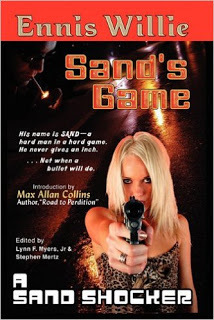
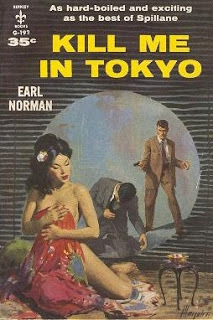 HARDBOILED CORNER: HIDDEN EYES PART 2 In last week’s column, I spotlighted two private eye series familiar only to the acolytes of the hardboiled inner circle—The Eye—whose knowledge and fanatical commitment to the genre keep the embers of even the most obscure fictional private eyes and tough guys alive. This week, I’ll expose three more hidden gems of the genre.
HARDBOILED CORNER: HIDDEN EYES PART 2 In last week’s column, I spotlighted two private eye series familiar only to the acolytes of the hardboiled inner circle—The Eye—whose knowledge and fanatical commitment to the genre keep the embers of even the most obscure fictional private eyes and tough guys alive. This week, I’ll expose three more hidden gems of the genre.
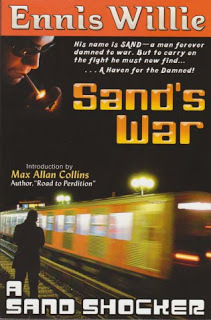 I must admit, I’m having way too much fun with this theme. While compiling my own list of obscure tough guy characters, I also reached out to some of my co-fanatics who contribute to the Men’s Adventure Paperbacks of the ‘70s and ‘80s Facebook group—Celebrating the two-fisted, heavily armed paperback adventure heroes of long-gone publishers like Pinnacle, Leisure, Zebra, etc....The Executioner. The Destroyer. The Death Merchant. The Protector. Nick Carter, Killmaster. The Penetrator. Black Samurai. Edge. The Hook. And so many more. In short order, they inundated me with enough private eyes, hitmen, vigilantes, tough crooks, tougher cops, and troubleshooters to fill this column for the rest of the year. I had either read or was familiar with most of the characters they mentioned—from both series or standalone novels—but there were definitely some I needed to check out for myself.
I must admit, I’m having way too much fun with this theme. While compiling my own list of obscure tough guy characters, I also reached out to some of my co-fanatics who contribute to the Men’s Adventure Paperbacks of the ‘70s and ‘80s Facebook group—Celebrating the two-fisted, heavily armed paperback adventure heroes of long-gone publishers like Pinnacle, Leisure, Zebra, etc....The Executioner. The Destroyer. The Death Merchant. The Protector. Nick Carter, Killmaster. The Penetrator. Black Samurai. Edge. The Hook. And so many more. In short order, they inundated me with enough private eyes, hitmen, vigilantes, tough crooks, tougher cops, and troubleshooters to fill this column for the rest of the year. I had either read or was familiar with most of the characters they mentioned—from both series or standalone novels—but there were definitely some I needed to check out for myself.
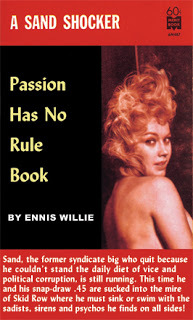 Anyone serious about tracking down these series and others should be familiar with these Internet resources: Kevin Burton Smith’s
THRILLING DETECTIVE
website is a comprehensive reference site for almost any detective series or character ever to grace the page; Joe Kenney’s
GLORIOUS TRASH
blog—where I have spent way too much time perusing the many books of my misspent youth—is filled with reviews and biting commentary on an outrageous number of paperback original men’s action/adventure series; Bruce Grossman’s
BULLETS, BROADS, BLACKMAIL, AND BOMBS
column on the
BOOKGASM
blog hits all the high points and low points of men’s action/adventure series; JOHNNY LARUE'S CRANE SHOT blog—trashy movies, trashy paperbacks, trashy old TV shows, trashy...well, you get the picture; and the
TRASH MENACE
blog—a review of men's adventure, pulp heroes, horror paperbacks, disposable culture, transgressive literature, and theme parks. Each of these sites will keep both hardcore and new fans busy for hours…
Anyone serious about tracking down these series and others should be familiar with these Internet resources: Kevin Burton Smith’s
THRILLING DETECTIVE
website is a comprehensive reference site for almost any detective series or character ever to grace the page; Joe Kenney’s
GLORIOUS TRASH
blog—where I have spent way too much time perusing the many books of my misspent youth—is filled with reviews and biting commentary on an outrageous number of paperback original men’s action/adventure series; Bruce Grossman’s
BULLETS, BROADS, BLACKMAIL, AND BOMBS
column on the
BOOKGASM
blog hits all the high points and low points of men’s action/adventure series; JOHNNY LARUE'S CRANE SHOT blog—trashy movies, trashy paperbacks, trashy old TV shows, trashy...well, you get the picture; and the
TRASH MENACE
blog—a review of men's adventure, pulp heroes, horror paperbacks, disposable culture, transgressive literature, and theme parks. Each of these sites will keep both hardcore and new fans busy for hours…
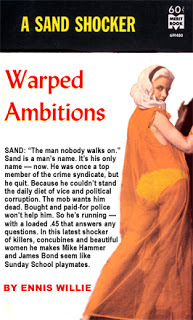 This week, I’m continuing with my own list of obscure favorites. This dynamic duo, like the Rafferty and Hardman series from last week, have been off the hardboiled genre’s radar for far too long. One of the toughest tough guys is Ennis Willie’s Sand—A former crime lord with a price on his head, an army of hit men on his back, and a .45 riding in a shoulder rig under his arm to do his talking. A man alone, with few friends and many hates. There is nowhere to hide…and it's too late to pray...
This week, I’m continuing with my own list of obscure favorites. This dynamic duo, like the Rafferty and Hardman series from last week, have been off the hardboiled genre’s radar for far too long. One of the toughest tough guys is Ennis Willie’s Sand—A former crime lord with a price on his head, an army of hit men on his back, and a .45 riding in a shoulder rig under his arm to do his talking. A man alone, with few friends and many hates. There is nowhere to hide…and it's too late to pray...
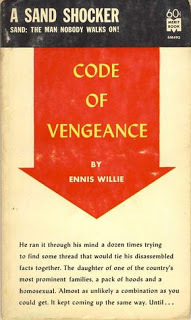 Short, terse, full of sex and graphic violence, the Sand Shockers, took their cue from Richard Stark’s far better known Parker novels. But Sand is far more than an imitation Parker. Sand’s violent cross-country crusade to break from his past as a mob hitman and rectify past wrongs—killing a morgue-full of minions and former mob bosses without qualms in the process—forms the template followed a decade later by Donald Pendleton’s Mack Bolan The Executioner series and its myriad of imitators.
Short, terse, full of sex and graphic violence, the Sand Shockers, took their cue from Richard Stark’s far better known Parker novels. But Sand is far more than an imitation Parker. Sand’s violent cross-country crusade to break from his past as a mob hitman and rectify past wrongs—killing a morgue-full of minions and former mob bosses without qualms in the process—forms the template followed a decade later by Donald Pendleton’s Mack Bolan The Executioner series and its myriad of imitators.
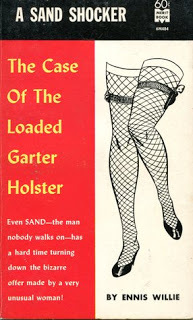 Ennis Willie wrote many novels published by the low-circulation sleaze imprint Merit Books in Chicago. Merit also published the nine Sand novels, but the distribution of Merit’s books was erratic at best, condemning the Sand Shockers to obscurity. However, the inner circle of hardboiled fanatics—in particular Stephen Mertz and Ed Gorman—have kept Sand’s flame alive, ensuring his continuing legacy.
Ennis Willie wrote many novels published by the low-circulation sleaze imprint Merit Books in Chicago. Merit also published the nine Sand novels, but the distribution of Merit’s books was erratic at best, condemning the Sand Shockers to obscurity. However, the inner circle of hardboiled fanatics—in particular Stephen Mertz and Ed Gorman—have kept Sand’s flame alive, ensuring his continuing legacy.
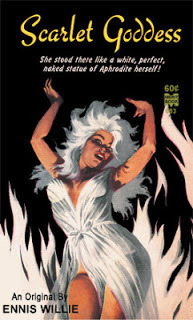 A hardboiled icon in his own right, Max Allan Collins acknowledges his series featuring tough crook Nolan and his later series with calculating hitman Quarry (soon to be seen on Cinemax) were inspired by Sand. Regarding Ennis Willie the writer, Collins declares, Among American writers, only one caught Mickey Spillane's magic—only one managed to create a fever-dream world of sadistic gangsters, willing women and larger-than-life tough guys. THE SAND SHOCKERS Scarlet Goddess (1963)Aura Of Sensuality (1963)Haven For The Damned (1963)Game Of Passion (1964)And Some Were Evil (1964)Warped Ambition (1964) The Case Of The Loaded Garter Holster (1964) Passion Has No Rule Book (1964) Code Of Vengeance (1965) The original Sand novels are incredibly rare and expensive, however, Ramble House has resurrected a number of Sand tales in two readily available collections,
SAND’S GAME
and
SAND’S WAR
FOR MORE ON ENNIS WILLIE CLICK HERE
A hardboiled icon in his own right, Max Allan Collins acknowledges his series featuring tough crook Nolan and his later series with calculating hitman Quarry (soon to be seen on Cinemax) were inspired by Sand. Regarding Ennis Willie the writer, Collins declares, Among American writers, only one caught Mickey Spillane's magic—only one managed to create a fever-dream world of sadistic gangsters, willing women and larger-than-life tough guys. THE SAND SHOCKERS Scarlet Goddess (1963)Aura Of Sensuality (1963)Haven For The Damned (1963)Game Of Passion (1964)And Some Were Evil (1964)Warped Ambition (1964) The Case Of The Loaded Garter Holster (1964) Passion Has No Rule Book (1964) Code Of Vengeance (1965) The original Sand novels are incredibly rare and expensive, however, Ramble House has resurrected a number of Sand tales in two readily available collections,
SAND’S GAME
and
SAND’S WAR
FOR MORE ON ENNIS WILLIE CLICK HERE
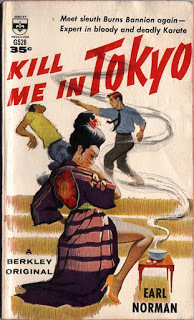 An American GI who remained in Tokyo as a Karate student after World War II, Burns Bannion was created by Earl Norman (Norman Thomson) in a series of nine paperback originals. Like the original Sand novels, the Bannion books are rare and expensive. Unlike Sand, there are no easily accessible reprints or collections. In 1958’s Kill Me In Tokyo, Burns Bannion gets his start as a private eye when he is mistaken for a real Californian PI who has followed a lead to Japan. Racial stereotypes abound in Bannion’s Japan, but if you can get beyond the political incorrectness (by today’s standards), the books are quick, hard hitting, and enjoyable reads. They are also possibly the first action novels to feature a westerner with martial arts skills.
An American GI who remained in Tokyo as a Karate student after World War II, Burns Bannion was created by Earl Norman (Norman Thomson) in a series of nine paperback originals. Like the original Sand novels, the Bannion books are rare and expensive. Unlike Sand, there are no easily accessible reprints or collections. In 1958’s Kill Me In Tokyo, Burns Bannion gets his start as a private eye when he is mistaken for a real Californian PI who has followed a lead to Japan. Racial stereotypes abound in Bannion’s Japan, but if you can get beyond the political incorrectness (by today’s standards), the books are quick, hard hitting, and enjoyable reads. They are also possibly the first action novels to feature a westerner with martial arts skills.
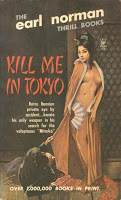
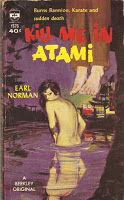
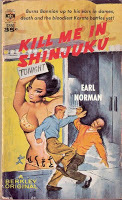
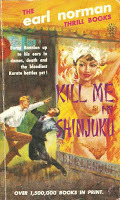
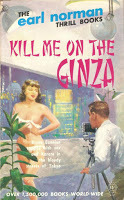
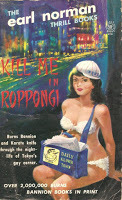
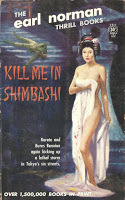
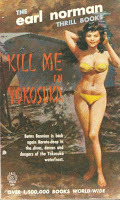
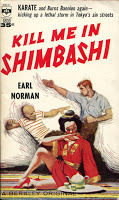
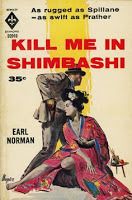
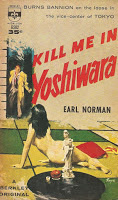 The covers of the first editions and all reprints have become collectable treasures, especially with great blurbs claiming Bannion to be blood brother to Shell Scott and Mike Hammer and a guy who keeps running into his two favorite pastimes—gorgeous girls and deadly killers. THE BURNS BANNION SERIES Kill Me in Tokyo (1958)Kill Me in Shimbashi (1959)Kill Me in Yokohama (1960)Kill Me in Yoshiwara (1961)Kill Me in Shinjunku (1961)Kill Me in Atami (1962)Kill Me on the Ginza (1962)Kill Me In Yokosuka (1966) Kill Me in Roppongi (1967)
The covers of the first editions and all reprints have become collectable treasures, especially with great blurbs claiming Bannion to be blood brother to Shell Scott and Mike Hammer and a guy who keeps running into his two favorite pastimes—gorgeous girls and deadly killers. THE BURNS BANNION SERIES Kill Me in Tokyo (1958)Kill Me in Shimbashi (1959)Kill Me in Yokohama (1960)Kill Me in Yoshiwara (1961)Kill Me in Shinjunku (1961)Kill Me in Atami (1962)Kill Me on the Ginza (1962)Kill Me In Yokosuka (1966) Kill Me in Roppongi (1967)
Published on June 27, 2016 19:42
June 23, 2016
HARDBOILED NOW: HIDDEN GEMS PART 1
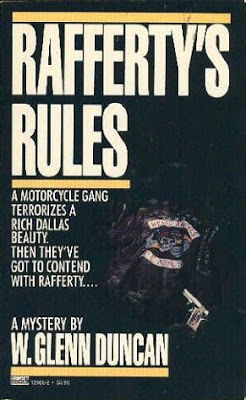
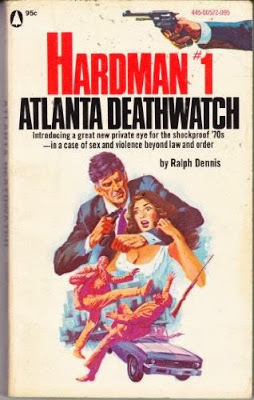 HARDBOILED NOW: HIDDEN GEMS PART 1
HARDBOILED NOW: HIDDEN GEMS PART 1
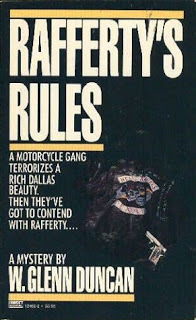 Modern fans of hardboiled private-eye novels often discovered the genre via Robert Crais’ Elvis Cole or Robert B. Parker’s Spenser. Women hardboiled fans also read Crais and Parker, but they often come to the genre through Sue Grafton’s Kinsey Millhone, Marcia Muller’s Sharon McCone, or Sara Paretsky’s V.I. Warshawski—who have also entertained many male readers. Casual readers usually stop with these names from the bestseller lists. However, others find themselves on the dangerous path to hardboiled addiction.
Modern fans of hardboiled private-eye novels often discovered the genre via Robert Crais’ Elvis Cole or Robert B. Parker’s Spenser. Women hardboiled fans also read Crais and Parker, but they often come to the genre through Sue Grafton’s Kinsey Millhone, Marcia Muller’s Sharon McCone, or Sara Paretsky’s V.I. Warshawski—who have also entertained many male readers. Casual readers usually stop with these names from the bestseller lists. However, others find themselves on the dangerous path to hardboiled addiction.
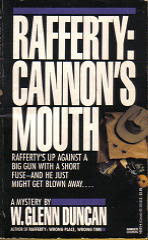 Thinking they can quit at any time, they begin chipping the original masters of the genre—the godhead of Chandler, Hammett, Ross MacDonald. Quickly, still denying their addiction, they look for further highs, uncovering John D. Macdonald or Mickey Spillane before scoring more modern masters—Lawrence Block, Estelman, Max Allan Collins, Bill Pronzini, Robert Randisi, Walter Mosely, Dennis Lehane, Andrew Vachss...
Thinking they can quit at any time, they begin chipping the original masters of the genre—the godhead of Chandler, Hammett, Ross MacDonald. Quickly, still denying their addiction, they look for further highs, uncovering John D. Macdonald or Mickey Spillane before scoring more modern masters—Lawrence Block, Estelman, Max Allan Collins, Bill Pronzini, Robert Randisi, Walter Mosely, Dennis Lehane, Andrew Vachss...
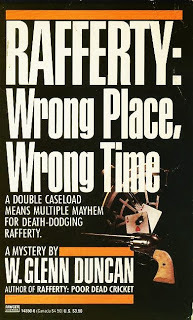 Falling further into the depths of their addiction deepen, hardboiled junkies score their highs from the private eye characters created by the likes of Wayne D. Dundee, Joe Gores, the ever dangerous Andrew Vachss, Jeremiah Healy, Arthur Lyons, Michael Collins (aka: Dennis Lynds), Stephen Greenleaf, Joseph Hansen, Jonathan Valin, and an almost never ending list of other two-fisted sleuths.
Falling further into the depths of their addiction deepen, hardboiled junkies score their highs from the private eye characters created by the likes of Wayne D. Dundee, Joe Gores, the ever dangerous Andrew Vachss, Jeremiah Healy, Arthur Lyons, Michael Collins (aka: Dennis Lynds), Stephen Greenleaf, Joseph Hansen, Jonathan Valin, and an almost never ending list of other two-fisted sleuths.
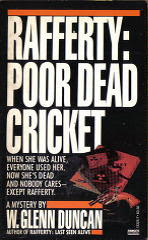 Falling further into the depths of their addiction deepen, desperate hardboiled addicts go old school for their kicks with the likes of Mike Shayne, Cool and Lam, Shell Scott, Johnny Liddell, Ellery Queen, Nero Wolfe, Dan Turner, and others from the golden age of private eyes. But eventually, even these hardboiled speedballs aren’t enough to satisfy a mainliner.
Falling further into the depths of their addiction deepen, desperate hardboiled addicts go old school for their kicks with the likes of Mike Shayne, Cool and Lam, Shell Scott, Johnny Liddell, Ellery Queen, Nero Wolfe, Dan Turner, and others from the golden age of private eyes. But eventually, even these hardboiled speedballs aren’t enough to satisfy a mainliner.
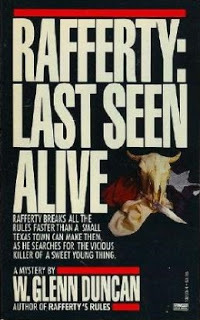 There remains only one place for these sad souls to go, a place known to only the most devoted of hardboiled fanatics. It is an opium den where the air is acrid with the residue of smoking guns, healing bruises, laddered stockings, and the underlying strains of a dying torch song. Here there be treasure—the treasures of The Eye, a hidden cabal of the hardboiled inner circle who tightly guard long forgotten, gritty paperback original private eyes series, which are passed from hand to hand with whispered reverence. In the spirit of the Masked Magician—only without the mask—who delights in revealing the mechanisms behind magic’s smoke and mirrors, I am going to devote the next few columns to unveiling the hidden treasures of private eye fiction…
There remains only one place for these sad souls to go, a place known to only the most devoted of hardboiled fanatics. It is an opium den where the air is acrid with the residue of smoking guns, healing bruises, laddered stockings, and the underlying strains of a dying torch song. Here there be treasure—the treasures of The Eye, a hidden cabal of the hardboiled inner circle who tightly guard long forgotten, gritty paperback original private eyes series, which are passed from hand to hand with whispered reverence. In the spirit of the Masked Magician—only without the mask—who delights in revealing the mechanisms behind magic’s smoke and mirrors, I am going to devote the next few columns to unveiling the hidden treasures of private eye fiction…
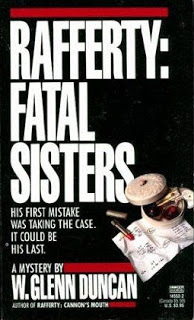 First up is a personal favorite—Rafferty, a tough ex-cop turned Texas private eye created by W. Glenn Duncan. Starting with Rafferty’s Rules (#39: Smiting the wicked sounds biblical, but mostly it's good clean fun) in 1987, this PBO (paperback original) series ran for six titles. At first blush, the framework for Rafferty appears to be yet another Spenser clone (Cowboy, Rafferty’s semi-sociopathic partner channeling Hawk; Hilda, Rafferty’s significant other who is a less irritating version of Susan Silverman; an equal number of wisecracks, fists, and bullets), but it’s quickly apparent in the first few pages of the series, Rafferty and company are in a class of their own. Rafferty doesn’t play well with others. He is stubbornly contrary, refusing to be told what to do or how to do anything. Being able to back his mouth up with smarts—or brute force when intelligence fails—is half the fun of the series. Rafferty is a refreshing throwback to the golden age of good, clean, hard-hitting, men’s action and adventure. Rafferty’s seemingly endless collections of rules provide a warped sense of ethics to his actions and we are happy to be along for the ride. Brash Books would drool to be able to reprint this series, but Duncan has somehow disappeared into the Australian Outback...Until search parties can locate him, interested parties will have to peruse used bookstores or the Internet. THE RAFFERTY SERIESRafferty's Rules (1987) Last Seen Alive (1987) Poor Dead Cricket (1988) Wrong Place, Wrong Time (1989) Cannon's Mouth (1990) Fatal Sisters (1990) FOR MORE ABOUT RAFFERTY CLICK HERE Another hidden PBO series horded by hardboiled aficionados is Ralph Dennis’, Hardman. Published in the ‘70s, the series remains one of the most overlooked and underestimated entries in the genre.
First up is a personal favorite—Rafferty, a tough ex-cop turned Texas private eye created by W. Glenn Duncan. Starting with Rafferty’s Rules (#39: Smiting the wicked sounds biblical, but mostly it's good clean fun) in 1987, this PBO (paperback original) series ran for six titles. At first blush, the framework for Rafferty appears to be yet another Spenser clone (Cowboy, Rafferty’s semi-sociopathic partner channeling Hawk; Hilda, Rafferty’s significant other who is a less irritating version of Susan Silverman; an equal number of wisecracks, fists, and bullets), but it’s quickly apparent in the first few pages of the series, Rafferty and company are in a class of their own. Rafferty doesn’t play well with others. He is stubbornly contrary, refusing to be told what to do or how to do anything. Being able to back his mouth up with smarts—or brute force when intelligence fails—is half the fun of the series. Rafferty is a refreshing throwback to the golden age of good, clean, hard-hitting, men’s action and adventure. Rafferty’s seemingly endless collections of rules provide a warped sense of ethics to his actions and we are happy to be along for the ride. Brash Books would drool to be able to reprint this series, but Duncan has somehow disappeared into the Australian Outback...Until search parties can locate him, interested parties will have to peruse used bookstores or the Internet. THE RAFFERTY SERIESRafferty's Rules (1987) Last Seen Alive (1987) Poor Dead Cricket (1988) Wrong Place, Wrong Time (1989) Cannon's Mouth (1990) Fatal Sisters (1990) FOR MORE ABOUT RAFFERTY CLICK HERE Another hidden PBO series horded by hardboiled aficionados is Ralph Dennis’, Hardman. Published in the ‘70s, the series remains one of the most overlooked and underestimated entries in the genre.
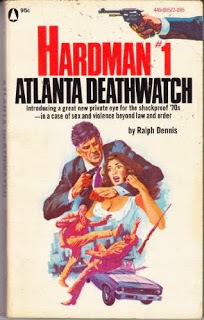 Jim Hardman, is a middle-aged, overweight, out of shape, ex-Atlanta cop turned unlicensed private eye. Despite his physical attributes, Hardman remains one tough bastard. When coupled with his partner, former Cleveland Browns pro-football player Hump Evans (yes, Hardman and Hump – get over it), the duo form a formidable team—Spenser and Hawk before there was a Spenser and Hawk. Despite the groundbreaking done by the television series I Spy, having an Afro-American sidekick who worked as an equal partner was fairly progressive for the time period.
Jim Hardman, is a middle-aged, overweight, out of shape, ex-Atlanta cop turned unlicensed private eye. Despite his physical attributes, Hardman remains one tough bastard. When coupled with his partner, former Cleveland Browns pro-football player Hump Evans (yes, Hardman and Hump – get over it), the duo form a formidable team—Spenser and Hawk before there was a Spenser and Hawk. Despite the groundbreaking done by the television series I Spy, having an Afro-American sidekick who worked as an equal partner was fairly progressive for the time period.
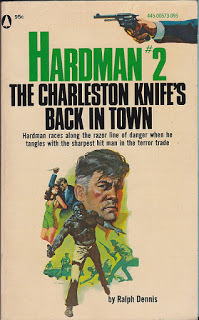 Hardman’s beat is Atlanta, a great city for kick ass action, which Dennis brings to harsh life using spare prose with a sprinkling of real nightclubs, restaurants, bars, hotels, and street corner descriptions throughout the series. Atlanta was the author’s adopted home, and his affection for the city is obvious. The books hold up surprisingly well. Dennis’ tells a good, violent, series of tales making Hardman, Hump, and Atlanta well worth making the effort to track down. The publisher, Popular Library, did the whole series a disservice—destining it for obscurity—by packaging it as a low-rent Executioner rip-off. The covers, however, are have become retro collectibles.
Hardman’s beat is Atlanta, a great city for kick ass action, which Dennis brings to harsh life using spare prose with a sprinkling of real nightclubs, restaurants, bars, hotels, and street corner descriptions throughout the series. Atlanta was the author’s adopted home, and his affection for the city is obvious. The books hold up surprisingly well. Dennis’ tells a good, violent, series of tales making Hardman, Hump, and Atlanta well worth making the effort to track down. The publisher, Popular Library, did the whole series a disservice—destining it for obscurity—by packaging it as a low-rent Executioner rip-off. The covers, however, are have become retro collectibles.
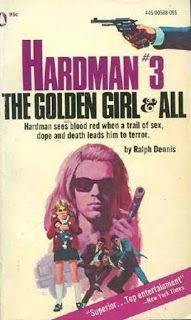 Hardman is another series ripe for reprinting, but the rights have proved difficult and expensive to disentangle. As an alternative, you can still find some of the series entries for affordable prices through the usual sources, but trying to put together the whole series from scratch will be a challenge. THE HARDMAN SERIES Atlanta Deathwatch (1974) The Charleston Knife's Back In Town (1974) The Golden Girl &Amp; All (1974) Pimp For The Dead (1974) Down Among The Jocks (1974) Murder's Not An Odd Job (1974) Working For The Man (1974) The Deadly Cotton Heart (1976) The One-Dollar Rip-Off (1977) Hump's First Case (1977) The Last Of The Armageddon Wars (1977) The Buy Back Blues (1977) FOR MORE ON HARDMAN CLICK HERE
Hardman is another series ripe for reprinting, but the rights have proved difficult and expensive to disentangle. As an alternative, you can still find some of the series entries for affordable prices through the usual sources, but trying to put together the whole series from scratch will be a challenge. THE HARDMAN SERIES Atlanta Deathwatch (1974) The Charleston Knife's Back In Town (1974) The Golden Girl &Amp; All (1974) Pimp For The Dead (1974) Down Among The Jocks (1974) Murder's Not An Odd Job (1974) Working For The Man (1974) The Deadly Cotton Heart (1976) The One-Dollar Rip-Off (1977) Hump's First Case (1977) The Last Of The Armageddon Wars (1977) The Buy Back Blues (1977) FOR MORE ON HARDMAN CLICK HERE
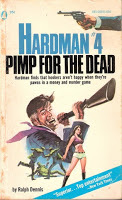
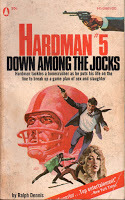
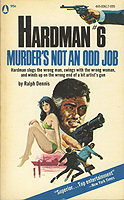
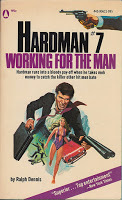
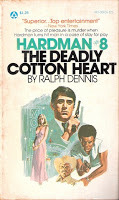
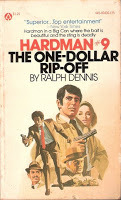
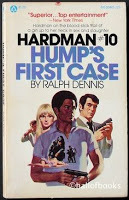
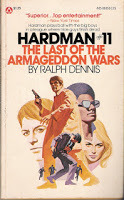
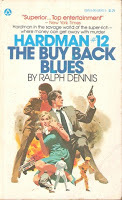 Next week I’ll be featuring three more obscure hardboiled gems…
Next week I’ll be featuring three more obscure hardboiled gems…
Published on June 23, 2016 15:54
HARDBOILED CORNER: THE MOST PRIVATE OF EYES

 THE MOST PRIVATE OF EYES
THE MOST PRIVATE OF EYES
 Modern fans of hardboiled private-eye novels often discovered the genre via Robert Crais’ Elvis Cole or Robert B. Parker’s Spenser. Women hardboiled fans also read Crais and Parker, but they often come to the genre through Sue Grafton’s Kinsey Millhone, Marcia Muller’s Sharon McCone, or Sara Paretsky’s V.I. Warshawski—who have also entertained many male readers. Casual readers usually stop with these names from the bestseller lists. However, others find themselves on the dangerous path to hardboiled addiction.
Modern fans of hardboiled private-eye novels often discovered the genre via Robert Crais’ Elvis Cole or Robert B. Parker’s Spenser. Women hardboiled fans also read Crais and Parker, but they often come to the genre through Sue Grafton’s Kinsey Millhone, Marcia Muller’s Sharon McCone, or Sara Paretsky’s V.I. Warshawski—who have also entertained many male readers. Casual readers usually stop with these names from the bestseller lists. However, others find themselves on the dangerous path to hardboiled addiction.
 Thinking they can quit at any time, they begin chipping the original masters of the genre—the godhead of Chandler, Hammett, Ross MacDonald. Quickly, still denying their addiction, they look for further highs, uncovering John D. Macdonald or Mickey Spillane before scoring more modern masters—Lawrence Block, Estelman, Max Allan Collins, Bill Pronzini, Robert Randisi, Walter Mosely, Dennis Lehane, Andrew Vachss...
Thinking they can quit at any time, they begin chipping the original masters of the genre—the godhead of Chandler, Hammett, Ross MacDonald. Quickly, still denying their addiction, they look for further highs, uncovering John D. Macdonald or Mickey Spillane before scoring more modern masters—Lawrence Block, Estelman, Max Allan Collins, Bill Pronzini, Robert Randisi, Walter Mosely, Dennis Lehane, Andrew Vachss...
 Falling further into the depths of their addiction deepen, hardboiled junkies score their highs from the private eye characters created by the likes of Wayne D. Dundee, Joe Gores, the ever dangerous Andrew Vachss, Jeremiah Healy, Arthur Lyons, Michael Collins (aka: Dennis Lynds), Stephen Greenleaf, Joseph Hansen, Jonathan Valin, and an almost never ending list of other two-fisted sleuths.
Falling further into the depths of their addiction deepen, hardboiled junkies score their highs from the private eye characters created by the likes of Wayne D. Dundee, Joe Gores, the ever dangerous Andrew Vachss, Jeremiah Healy, Arthur Lyons, Michael Collins (aka: Dennis Lynds), Stephen Greenleaf, Joseph Hansen, Jonathan Valin, and an almost never ending list of other two-fisted sleuths.
 Falling further into the depths of their addiction deepen, desperate hardboiled addicts go old school for their kicks with the likes of Mike Shayne, Cool and Lam, Shell Scott, Johnny Liddell, Ellery Queen, Nero Wolfe, Dan Turner, and others from the golden age of private eyes. But eventually, even these hardboiled speedballs aren’t enough to satisfy a mainliner.
Falling further into the depths of their addiction deepen, desperate hardboiled addicts go old school for their kicks with the likes of Mike Shayne, Cool and Lam, Shell Scott, Johnny Liddell, Ellery Queen, Nero Wolfe, Dan Turner, and others from the golden age of private eyes. But eventually, even these hardboiled speedballs aren’t enough to satisfy a mainliner.
 There remains only one place for these sad souls to go, a place known to only the most devoted of hardboiled fanatics. It is an opium den where the air is acrid with the residue of smoking guns, healing bruises, laddered stockings, and the underlying strains of a dying torch song. Here there be treasure—the treasures of The Eye, a hidden cabal of the hardboiled inner circle who tightly guard long forgotten, gritty paperback original private eyes series, which are passed from hand to hand with whispered reverence. In the spirit of the Masked Magician—only without the mask—who delights in revealing the mechanisms behind magic’s smoke and mirrors, I am going to devote the next few columns to unveiling the hidden treasures of private eye fiction…
There remains only one place for these sad souls to go, a place known to only the most devoted of hardboiled fanatics. It is an opium den where the air is acrid with the residue of smoking guns, healing bruises, laddered stockings, and the underlying strains of a dying torch song. Here there be treasure—the treasures of The Eye, a hidden cabal of the hardboiled inner circle who tightly guard long forgotten, gritty paperback original private eyes series, which are passed from hand to hand with whispered reverence. In the spirit of the Masked Magician—only without the mask—who delights in revealing the mechanisms behind magic’s smoke and mirrors, I am going to devote the next few columns to unveiling the hidden treasures of private eye fiction…
 First up is a personal favorite—Rafferty, a tough ex-cop turned Texas private eye created by W. Glenn Duncan. Starting with Rafferty’s Rules (#39: Smiting the wicked sounds biblical, but mostly it's good clean fun) in 1987, this PBO (paperback original) series ran for six titles. At first blush, the framework for Rafferty appears to be yet another Spenser clone (Cowboy, Rafferty’s semi-sociopathic partner channeling Hawk; Hilda, Rafferty’s significant other who is a less irritating version of Susan Silverman; an equal number of wisecracks, fists, and bullets), but it’s quickly apparent in the first few pages of the series, Rafferty and company are in a class of their own. Rafferty doesn’t play well with others. He is stubbornly contrary, refusing to be told what to do or how to do anything. Being able to back his mouth up with smarts—or brute force when intelligence fails—is half the fun of the series. Rafferty is a refreshing throwback to the golden age of good, clean, hard-hitting, men’s action and adventure. Rafferty’s seemingly endless collections of rules provide a warped sense of ethics to his actions and we are happy to be along for the ride. Brash Books would drool to be able to reprint this series, but Duncan has somehow disappeared into the Australian Outback...Until search parties can locate him, interested parties will have to peruse used bookstores or the Internet. THE RAFFERTY SERIESRafferty's Rules (1987) Last Seen Alive (1987) Poor Dead Cricket (1988) Wrong Place, Wrong Time (1989) Cannon's Mouth (1990) Fatal Sisters (1990) FOR MORE ABOUT RAFFERTY CLICK HERE Another hidden PBO series horded by hardboiled aficionados is Ralph Dennis’, Hardman. Published in the ‘70s, the series remains one of the most overlooked and underestimated entries in the genre.
First up is a personal favorite—Rafferty, a tough ex-cop turned Texas private eye created by W. Glenn Duncan. Starting with Rafferty’s Rules (#39: Smiting the wicked sounds biblical, but mostly it's good clean fun) in 1987, this PBO (paperback original) series ran for six titles. At first blush, the framework for Rafferty appears to be yet another Spenser clone (Cowboy, Rafferty’s semi-sociopathic partner channeling Hawk; Hilda, Rafferty’s significant other who is a less irritating version of Susan Silverman; an equal number of wisecracks, fists, and bullets), but it’s quickly apparent in the first few pages of the series, Rafferty and company are in a class of their own. Rafferty doesn’t play well with others. He is stubbornly contrary, refusing to be told what to do or how to do anything. Being able to back his mouth up with smarts—or brute force when intelligence fails—is half the fun of the series. Rafferty is a refreshing throwback to the golden age of good, clean, hard-hitting, men’s action and adventure. Rafferty’s seemingly endless collections of rules provide a warped sense of ethics to his actions and we are happy to be along for the ride. Brash Books would drool to be able to reprint this series, but Duncan has somehow disappeared into the Australian Outback...Until search parties can locate him, interested parties will have to peruse used bookstores or the Internet. THE RAFFERTY SERIESRafferty's Rules (1987) Last Seen Alive (1987) Poor Dead Cricket (1988) Wrong Place, Wrong Time (1989) Cannon's Mouth (1990) Fatal Sisters (1990) FOR MORE ABOUT RAFFERTY CLICK HERE Another hidden PBO series horded by hardboiled aficionados is Ralph Dennis’, Hardman. Published in the ‘70s, the series remains one of the most overlooked and underestimated entries in the genre.
 Jim Hardman, is a middle-aged, overweight, out of shape, ex-Atlanta cop turned unlicensed private eye. Despite his physical attributes, Hardman remains one tough bastard. When coupled with his partner, former Cleveland Browns pro-football player Hump Evans (yes, Hardman and Hump – get over it), the duo form a formidable team—Spenser and Hawk before there was a Spenser and Hawk. Despite the groundbreaking done by the television series I Spy, having an Afro-American sidekick who worked as an equal partner was fairly progressive for the time period.
Jim Hardman, is a middle-aged, overweight, out of shape, ex-Atlanta cop turned unlicensed private eye. Despite his physical attributes, Hardman remains one tough bastard. When coupled with his partner, former Cleveland Browns pro-football player Hump Evans (yes, Hardman and Hump – get over it), the duo form a formidable team—Spenser and Hawk before there was a Spenser and Hawk. Despite the groundbreaking done by the television series I Spy, having an Afro-American sidekick who worked as an equal partner was fairly progressive for the time period.
 Hardman’s beat is Atlanta, a great city for kick ass action, which Dennis brings to harsh life using spare prose with a sprinkling of real nightclubs, restaurants, bars, hotels, and street corner descriptions throughout the series. Atlanta was the author’s adopted home, and his affection for the city is obvious. The books hold up surprisingly well. Dennis’ tells a good, violent, series of tales making Hardman, Hump, and Atlanta well worth making the effort to track down. The publisher, Popular Library, did the whole series a disservice—destining it for obscurity—by packaging it as a low-rent Executioner rip-off. The covers, however, are have become retro collectibles.
Hardman’s beat is Atlanta, a great city for kick ass action, which Dennis brings to harsh life using spare prose with a sprinkling of real nightclubs, restaurants, bars, hotels, and street corner descriptions throughout the series. Atlanta was the author’s adopted home, and his affection for the city is obvious. The books hold up surprisingly well. Dennis’ tells a good, violent, series of tales making Hardman, Hump, and Atlanta well worth making the effort to track down. The publisher, Popular Library, did the whole series a disservice—destining it for obscurity—by packaging it as a low-rent Executioner rip-off. The covers, however, are have become retro collectibles.
 Hardman is another series ripe for reprinting, but the rights have proved difficult and expensive to disentangle. As an alternative, you can still find some of the series entries for affordable prices through the usual sources, but trying to put together the whole series from scratch will be a challenge. THE HARDMAN SERIES Atlanta Deathwatch (1974) The Charleston Knife's Back In Town (1974) The Golden Girl &Amp; All (1974) Pimp For The Dead (1974) Down Among The Jocks (1974) Murder's Not An Odd Job (1974) Working For The Man (1974) The Deadly Cotton Heart (1976) The One-Dollar Rip-Off (1977) Hump's First Case (1977) The Last Of The Armageddon Wars (1977) The Buy Back Blues (1977) FOR MORE ON HARDMAN CLICK HERE
Hardman is another series ripe for reprinting, but the rights have proved difficult and expensive to disentangle. As an alternative, you can still find some of the series entries for affordable prices through the usual sources, but trying to put together the whole series from scratch will be a challenge. THE HARDMAN SERIES Atlanta Deathwatch (1974) The Charleston Knife's Back In Town (1974) The Golden Girl &Amp; All (1974) Pimp For The Dead (1974) Down Among The Jocks (1974) Murder's Not An Odd Job (1974) Working For The Man (1974) The Deadly Cotton Heart (1976) The One-Dollar Rip-Off (1977) Hump's First Case (1977) The Last Of The Armageddon Wars (1977) The Buy Back Blues (1977) FOR MORE ON HARDMAN CLICK HERE








 Next week I’ll be featuring three more obscure hardboiled gems…
Next week I’ll be featuring three more obscure hardboiled gems…
Published on June 23, 2016 15:54
June 9, 2016
GET READY FOR THE STORME
 GET READY FOR THE STORME Recently, upstart publisher
Brash Books
has been setting readers’ enthusiasm on fire by making many long out of print mystery series available again in both e-books and beautiful trade paperbacks. In some cases, Brash Books has commissioned new books in these series, either from the original author or by continuing the series under the guidance of a new author. Because of Brash Books, these excellent series are returning from ill-deserved obscurity and being given new life as they are discovered by a new generation of passionate mystery fans. To mentioning a few of these gems fires my own enthusiasm as I remember discovering them the first time around—The Owl by Bob Forward, The Bragg private eye series from Jack Lynch, the action filled Preacher novels from Ted Thackery, and the Delilah West mysteries from Maxine O'Callaghan. It’s terrific to see them available again, and I have now reread quite a few and found them to be as enjoyable as I remembered.
GET READY FOR THE STORME Recently, upstart publisher
Brash Books
has been setting readers’ enthusiasm on fire by making many long out of print mystery series available again in both e-books and beautiful trade paperbacks. In some cases, Brash Books has commissioned new books in these series, either from the original author or by continuing the series under the guidance of a new author. Because of Brash Books, these excellent series are returning from ill-deserved obscurity and being given new life as they are discovered by a new generation of passionate mystery fans. To mentioning a few of these gems fires my own enthusiasm as I remember discovering them the first time around—The Owl by Bob Forward, The Bragg private eye series from Jack Lynch, the action filled Preacher novels from Ted Thackery, and the Delilah West mysteries from Maxine O'Callaghan. It’s terrific to see them available again, and I have now reread quite a few and found them to be as enjoyable as I remembered.
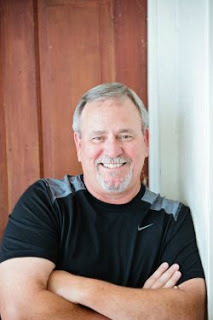 The series I am most delighted to see making a strong comeback features W.L. Ripley’s character, Wyatt Storme. In the early ‘90s, Ripley introduced ex-NFL star, atavistic cowboy, and freelance troubleshooter Wyatt Storme in Dreamsicle. At first glance, Storme and his tougher than tough sidekick Chick Easton appeared to be another take on Spenser and Hawk. However, once I started reading, it became clear Ripley had the chops to break away from the Spenser clones in the same way Robert Crais did with his acclaimed series featuring Elvis Cole and his slightly psychotic sidekick, Joe Pike. When the second and third Storme adventures (Storme Front / Electric Country Roulette) were even stronger than Storme’s debut (Dreamsicle), I believed Ripley had created a series that would be around for a long time. However, the machinations of the publishing industry’s impatient treatment of mid-list writers conspired to cut the series off before it had a chance to reach a wider audience and the acclaim it deserved. Ripley went on to write another outstanding three book series—featuring the enigmatic ex-secret service agent Cole Springer (Springer’s Gambit / Pressing The Bet / Springer’s Fortune), who could easily be a brother or at least a first cousin to Wyatt Storme. While different in their own right, the Springer books displayed the same engaging writing style, the same biting dry wit, and the same crunching action from an intelligent hero you would definitely want beside you in a fight. I thoroughly enjoyed the Springer novels, but I also wanted more Storme…And now, thanks to Brash Books, Storme is back—in retitled (Hail Storme / Storm Front / Eye Of The Storme), repackaged (beautiful covers with matching theme in e-book and paperback), versions of his original adventures, but also in a brand new novel, Storme Warning. As excited as I am to have Wyatt Storme back in my reading line-up, I can assure you the author W.L. Ripley is even more excited. I tracked Ripley—AKA: The Blue Collar Elmore Leonard and The Heir to John D. McDonald—to his home in western Missouri. Caught in the act of writing a new chapter, he has been dragged into the virtual interrogation room where the bright lights give him nowhere to hide...Hopefully, he’ll talk without the application of the rubber hoses...
What can you tell us about the genesis and history of Wyatt Storme and your early writing career?
RIPLEY: I’d been brain-storming Wyatt Storme for a few years before putting him on paper. Probably wrote several thousand words about him in different scenarios, even different names, before I decided who he would be. The first Storme novel, Hail Storme, was an easy write (It’s not always that way). It came in one long fine flash and pretty much wrote itself.
When did Cole Springer come into being and how did you strive to make him different to Wyatt Storme?
The series I am most delighted to see making a strong comeback features W.L. Ripley’s character, Wyatt Storme. In the early ‘90s, Ripley introduced ex-NFL star, atavistic cowboy, and freelance troubleshooter Wyatt Storme in Dreamsicle. At first glance, Storme and his tougher than tough sidekick Chick Easton appeared to be another take on Spenser and Hawk. However, once I started reading, it became clear Ripley had the chops to break away from the Spenser clones in the same way Robert Crais did with his acclaimed series featuring Elvis Cole and his slightly psychotic sidekick, Joe Pike. When the second and third Storme adventures (Storme Front / Electric Country Roulette) were even stronger than Storme’s debut (Dreamsicle), I believed Ripley had created a series that would be around for a long time. However, the machinations of the publishing industry’s impatient treatment of mid-list writers conspired to cut the series off before it had a chance to reach a wider audience and the acclaim it deserved. Ripley went on to write another outstanding three book series—featuring the enigmatic ex-secret service agent Cole Springer (Springer’s Gambit / Pressing The Bet / Springer’s Fortune), who could easily be a brother or at least a first cousin to Wyatt Storme. While different in their own right, the Springer books displayed the same engaging writing style, the same biting dry wit, and the same crunching action from an intelligent hero you would definitely want beside you in a fight. I thoroughly enjoyed the Springer novels, but I also wanted more Storme…And now, thanks to Brash Books, Storme is back—in retitled (Hail Storme / Storm Front / Eye Of The Storme), repackaged (beautiful covers with matching theme in e-book and paperback), versions of his original adventures, but also in a brand new novel, Storme Warning. As excited as I am to have Wyatt Storme back in my reading line-up, I can assure you the author W.L. Ripley is even more excited. I tracked Ripley—AKA: The Blue Collar Elmore Leonard and The Heir to John D. McDonald—to his home in western Missouri. Caught in the act of writing a new chapter, he has been dragged into the virtual interrogation room where the bright lights give him nowhere to hide...Hopefully, he’ll talk without the application of the rubber hoses...
What can you tell us about the genesis and history of Wyatt Storme and your early writing career?
RIPLEY: I’d been brain-storming Wyatt Storme for a few years before putting him on paper. Probably wrote several thousand words about him in different scenarios, even different names, before I decided who he would be. The first Storme novel, Hail Storme, was an easy write (It’s not always that way). It came in one long fine flash and pretty much wrote itself.
When did Cole Springer come into being and how did you strive to make him different to Wyatt Storme?
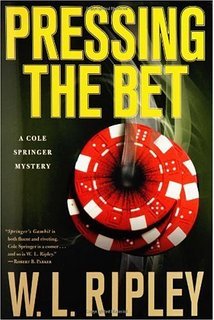 RIPLEY: The Storme novels are written in first person point-of-view. Everything happens through Storme’s eyes. The Springer novels are third person omniscient where I can walk through the minds of all the characters, even the bad guys. Storme is very much the stalwart neo-classic Western hero. He doesn’t drink or use profanity. Springer is a free swinging, piano playing honest con-man with a wicked sense of humor who enjoys the game he’s playing with his enemies. Springer would rather out-smart than out-punch his adversaries. Think of Storme as a witty Clint Eastwood/Gary Cooper character, whereas Cole Springer would be more of a James Garner/Paul Newman type with a wink, a smile and quip. Storme comes at his adversaries straight up while Springer likes to approach his antagonists sideways, allowing them to trip themselves up with their greed. I wanted a different type of hero in a different setting and, having visited Aspen Colorado on a few occasions, I was fascinated by the locale and the demographics of the place. I also wanted to place the enigmatic ex-Secret Service agent in a culture clash with some nasty mobsters. It is hard to beat Aspen, Colorado, as a culture shock venue for street thugs. Makes it a lot of fun to thrust those thugs into the rarified air of celebrities and the beautiful people.
How did your association with Brash Books come about and what excites you most about having your Wyatt Storme books readily available again in print and also in e-book format?
RIPLEY: Lee Goldberg and Joel Goldman (Brash Books publishers) were searching for mystery writers for their new imprint. Lee came across my name in a foreword acknowledgment in an Ace Atkins’ book and contacted Atkins. Ace told them how to get hold of me. Lee and Joel hooked me into a conference call, laid out the Brash Books vision, and I was hooked.
RIPLEY: The Storme novels are written in first person point-of-view. Everything happens through Storme’s eyes. The Springer novels are third person omniscient where I can walk through the minds of all the characters, even the bad guys. Storme is very much the stalwart neo-classic Western hero. He doesn’t drink or use profanity. Springer is a free swinging, piano playing honest con-man with a wicked sense of humor who enjoys the game he’s playing with his enemies. Springer would rather out-smart than out-punch his adversaries. Think of Storme as a witty Clint Eastwood/Gary Cooper character, whereas Cole Springer would be more of a James Garner/Paul Newman type with a wink, a smile and quip. Storme comes at his adversaries straight up while Springer likes to approach his antagonists sideways, allowing them to trip themselves up with their greed. I wanted a different type of hero in a different setting and, having visited Aspen Colorado on a few occasions, I was fascinated by the locale and the demographics of the place. I also wanted to place the enigmatic ex-Secret Service agent in a culture clash with some nasty mobsters. It is hard to beat Aspen, Colorado, as a culture shock venue for street thugs. Makes it a lot of fun to thrust those thugs into the rarified air of celebrities and the beautiful people.
How did your association with Brash Books come about and what excites you most about having your Wyatt Storme books readily available again in print and also in e-book format?
RIPLEY: Lee Goldberg and Joel Goldman (Brash Books publishers) were searching for mystery writers for their new imprint. Lee came across my name in a foreword acknowledgment in an Ace Atkins’ book and contacted Atkins. Ace told them how to get hold of me. Lee and Joel hooked me into a conference call, laid out the Brash Books vision, and I was hooked.
 Seeing your name in print with fresh eye-catching covers never gets old. Goldberg and Goldman (both successful novelists in their own right) are very unique in the publishing industry. Both men truly love mysteries and their writers. They are two of the hardest working men I’ve ever encountered. That’s saying a lot as I was once a college basketball coach, a profession filled with 24-7 workaholics. The G-Men love what they’re doing and it is infectious. I don’t know anyone who has more fun all the time than Lee Goldberg, and few people possess a more organized and focused mind than Joel Goldman. They are the Wyatt Storme and Chick Easton of the industry.
How much input did you have in the repackaging of your first three Wyatt Storme novels with new titles and new covers?
RIPLEY: Brash has been great about getting input on cover art and blurbs. Lee Goldberg wanted a trademark Stormelook for each book cover, which has turned out to be a great idea. I’m not much on cover art, but my son, Jared, has a great critical eye and Brash has paid attention to his input. Jared, an art teacher, is the one who came up with the Eye of the Storme bullet-hole trademark.
Seeing your name in print with fresh eye-catching covers never gets old. Goldberg and Goldman (both successful novelists in their own right) are very unique in the publishing industry. Both men truly love mysteries and their writers. They are two of the hardest working men I’ve ever encountered. That’s saying a lot as I was once a college basketball coach, a profession filled with 24-7 workaholics. The G-Men love what they’re doing and it is infectious. I don’t know anyone who has more fun all the time than Lee Goldberg, and few people possess a more organized and focused mind than Joel Goldman. They are the Wyatt Storme and Chick Easton of the industry.
How much input did you have in the repackaging of your first three Wyatt Storme novels with new titles and new covers?
RIPLEY: Brash has been great about getting input on cover art and blurbs. Lee Goldberg wanted a trademark Stormelook for each book cover, which has turned out to be a great idea. I’m not much on cover art, but my son, Jared, has a great critical eye and Brash has paid attention to his input. Jared, an art teacher, is the one who came up with the Eye of the Storme bullet-hole trademark.
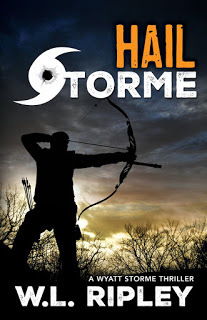 Brash is so good at promo and jacket blurbs I don’t have to worry about those things very much anymore. Previously, with other publishers, I had to do most of it. From the Brash Books Eye Of The Storme page comes this line: Storme rolls into Branson like a hurricane with his buddy Chick Easton, an unhinged ex-CIA operative, to settle the score with his own brand of Justice. I didn't write that, but I wish I had. Brash is very mindful of the Wyatt Storme Brand and work with me to insure the best product is put forth to the public.
Brash is so good at promo and jacket blurbs I don’t have to worry about those things very much anymore. Previously, with other publishers, I had to do most of it. From the Brash Books Eye Of The Storme page comes this line: Storme rolls into Branson like a hurricane with his buddy Chick Easton, an unhinged ex-CIA operative, to settle the score with his own brand of Justice. I didn't write that, but I wish I had. Brash is very mindful of the Wyatt Storme Brand and work with me to insure the best product is put forth to the public. Before signing on with Brash Books did you consider republishing the Wyatt Storme books yourself, and if so, what made you decide Brash Books was the right fit for you? RIPLEY: Good question. Yes, I was considering self-publishing Storme as I had been watching the mushrooming e-book industry and the early Storme novels had been published before the boom.
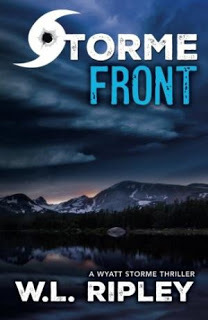 Brash shared with me a long-term vision of what they wanted to do and where they were going and I was intrigued. They are on the cutting edge of this revolution and I’m very happy to have gotten in on the ground floor. My books are moving at the best pace they’ve ever enjoyed. Brash’s promo has even generated new books sales for my non-Brash titles. Springer’s Fortune (2013) has experienced a surge in sales and it is directly tied to what Brash has done to expose tens of thousands of new readers to the Wyatt Storme series.
I’m excited there is also a new Wyatt Storme adventure waiting to be published. Is this a book you wrote shortly after the third Wyatt Storme book was originally published, or was this written specifically for Brash Books?
RIPLEY: The newest Storme, Storme Warning, was a new Storme written for Brash. I had a first draft written when they contacted me initially. Again, Ace Atkins had read it and told Joel Goldman about it.
Are there more Wyatt Storme book planned?
RIPLEY: Yes, working on one now and have another in development. Working title is Thunder Storme.
How do you keep the character of Wyatt Storme consistent as he makes his return appearances—have you changed as a writer; has Wyatt Storme changed as a character?
Brash shared with me a long-term vision of what they wanted to do and where they were going and I was intrigued. They are on the cutting edge of this revolution and I’m very happy to have gotten in on the ground floor. My books are moving at the best pace they’ve ever enjoyed. Brash’s promo has even generated new books sales for my non-Brash titles. Springer’s Fortune (2013) has experienced a surge in sales and it is directly tied to what Brash has done to expose tens of thousands of new readers to the Wyatt Storme series.
I’m excited there is also a new Wyatt Storme adventure waiting to be published. Is this a book you wrote shortly after the third Wyatt Storme book was originally published, or was this written specifically for Brash Books?
RIPLEY: The newest Storme, Storme Warning, was a new Storme written for Brash. I had a first draft written when they contacted me initially. Again, Ace Atkins had read it and told Joel Goldman about it.
Are there more Wyatt Storme book planned?
RIPLEY: Yes, working on one now and have another in development. Working title is Thunder Storme.
How do you keep the character of Wyatt Storme consistent as he makes his return appearances—have you changed as a writer; has Wyatt Storme changed as a character?
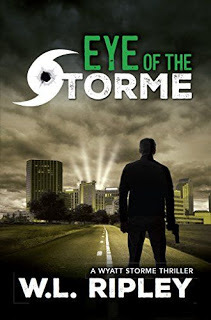 RIPLEY: Storme is larger-than-life throwback character who has gone through a marked change of course—from NFL superstar playboy to Thoreau inspired societal drop-out. He is very much his own man living by his own code. His sidekick, the enigmatic and unpredictable Chick Easton is, in Storme’s own words, the Swiss Army Knife of friends. Both men are haunted by their past exploits, but are learning to deal with them in the present. The trick with a series character is to keep the hero familiar to long-time readers and at the same time appeal to new readers. Storme and Easton change in incremental ways each book, hopefully in ways pleasing to my readers. I try to peel back enticing little layers of the characters with each new novel. As a writer, I have changed due the influence of other writers, agents and editors. I have had two agents who have had a great impact on my writing style and growth as a writer. I have to give Donald Maass of Donald Maass Literary agency much credit for helping me to see different avenues in my work. Al Zuckerman, Ken Follett’s agent, was my agent for a short period of time. We didn’t get along well, it happens, but I learned much from him that has progressed my work. There is so much to learn from people in the industry if a writer is open to criticism. Lee Goldberg has had an impact on my vision for Storme and Easton and Jake Morgan. Goldman also. The fact Goldman lives within 45 minutes of my home gives me access to his input on a personal basis. As a writer I’m in competition with my previous works. I really don’t feel a competition with other writers. I hope all writers succeed as I have a great appreciation for the amount of work that goes into a novel. This is an offshoot of my coaching career. I was never jealous of other coaches as they were the only people in a crowded fieldhouse who were going through the same thing I was. I concentrated on the floor situation, my players and my team. The same with my novels. I’m too focused on my work and my characters to worry about what other authors are doing.
What can you tells us about the fourth Wyatt Storme book, Storme Warning?
RIPLEY: Storme is placed in a situation outside his comfort zone—dealing with Hollywood celebrities and the attendant media—and it is all due the urgings of Chick Easton. Storme and Easton are protecting a prima donna actor who nearly everyone involved in the film’s production has motive to kill. As Chick says, “Hell, I want to kill him and I just met him.” Storme doesn’t want anything to do with the film crew, but his bond with Easton, who is excited about the prospect, pulls Storme into the mix. Hovering around the edge of things is a nasty mob button-man who has a personal and murderous grudge against Storme.
What is the one thing about Wyatt Storme you would want new readers to know?
RIPLEY: Storme is larger-than-life throwback character who has gone through a marked change of course—from NFL superstar playboy to Thoreau inspired societal drop-out. He is very much his own man living by his own code. His sidekick, the enigmatic and unpredictable Chick Easton is, in Storme’s own words, the Swiss Army Knife of friends. Both men are haunted by their past exploits, but are learning to deal with them in the present. The trick with a series character is to keep the hero familiar to long-time readers and at the same time appeal to new readers. Storme and Easton change in incremental ways each book, hopefully in ways pleasing to my readers. I try to peel back enticing little layers of the characters with each new novel. As a writer, I have changed due the influence of other writers, agents and editors. I have had two agents who have had a great impact on my writing style and growth as a writer. I have to give Donald Maass of Donald Maass Literary agency much credit for helping me to see different avenues in my work. Al Zuckerman, Ken Follett’s agent, was my agent for a short period of time. We didn’t get along well, it happens, but I learned much from him that has progressed my work. There is so much to learn from people in the industry if a writer is open to criticism. Lee Goldberg has had an impact on my vision for Storme and Easton and Jake Morgan. Goldman also. The fact Goldman lives within 45 minutes of my home gives me access to his input on a personal basis. As a writer I’m in competition with my previous works. I really don’t feel a competition with other writers. I hope all writers succeed as I have a great appreciation for the amount of work that goes into a novel. This is an offshoot of my coaching career. I was never jealous of other coaches as they were the only people in a crowded fieldhouse who were going through the same thing I was. I concentrated on the floor situation, my players and my team. The same with my novels. I’m too focused on my work and my characters to worry about what other authors are doing.
What can you tells us about the fourth Wyatt Storme book, Storme Warning?
RIPLEY: Storme is placed in a situation outside his comfort zone—dealing with Hollywood celebrities and the attendant media—and it is all due the urgings of Chick Easton. Storme and Easton are protecting a prima donna actor who nearly everyone involved in the film’s production has motive to kill. As Chick says, “Hell, I want to kill him and I just met him.” Storme doesn’t want anything to do with the film crew, but his bond with Easton, who is excited about the prospect, pulls Storme into the mix. Hovering around the edge of things is a nasty mob button-man who has a personal and murderous grudge against Storme.
What is the one thing about Wyatt Storme you would want new readers to know?
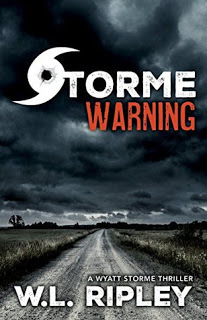 RIPLEY: Wyatt Storme is a neo-classic Western hero set in the Modern American West. He is a real dead ringer for something like you’ve never seen (apologies to J. Robbie Robertson of The Band). Storme is reclusive and private, whereas Chick Easton is an exclamation point with legs who often goads Storme back into the vortex of the modern culture Storme disdains. The literary hero Storme most approximates would be John D. McDonald’s Travis McGee, another modern knight errant and societal drop-out.
Does the future have Cole Springer getting the same great Brash Books treatment as Wyatt Storme?
RIPLEY: We’ve talked about it and I do have two new Springers developed, so Springer will be back at some point. Right now the focus is on Wyatt Storme and continuing to build his readership which is going well.
Your Brash Book author’s page mentions a potential new series you are creating…What can you tell us about it?
RIPLEY: I have a new character, Jake Morgan, a modern twenty-something Texas Ranger who returns to his Midwestern hometown, and learns you can’t go home again. At least Morgan can’t as he finds his hometown under assault from powerful forces not hesitant to kill to consolidate their power. Morgan quickly clashes with the most powerful family in the area, which includes his high school sweetheart. She has become a dominant and imposing figure, and tensions rise as Jake begins an unauthorized—and unwanted—probe into the accidental death of an old friend. I appreciate Rip taking time from his writing schedule to discuss his experiences with Brash Books and Wyatt Storme. If you haven’t met Wyatt Storme, now is your chance...If you are already acquainted with Storme, it’s time to experience his early adventures again to get ready for all the action coming up from his new adventures… THE WYATT STORME NOVELS HAIL STORME: The first Wyatt Storme novel. Storme is hunting in Missouri when he stumbles upon a hidden field of marijuana…and becomes embroiled in a deadly conspiracy of corruption, drug-trafficking and organized crime.
CLICK HERE
STORME FRONT: To help a desperate friend, ex-footballer Wyatt Storme and his hard-charging buddy Chick Easton ride shotgun on an illegal gun shipment...and things go very wrong. The second novel in the action-packed series.
CLICK HERE
EYE OF THE STORME: Wyatt Storme investigates the rape of a young co-ed in Branson, Missouri in this action-packed, third adventure in the series.
CLICK HERE
STORME WARNING: The fourth novel featuring Wyatt Storme, the ex-football player turned troubleshooter that critics are hailing as the long-awaited heir to Travis McGee and Spenser. This time, Storme is hired to protect a bad-boy movie star getting well-deserved death threats.
CLICK HERE
FOR MORE ON W.L. RIPLEY
CLICK HERE
RIPLEY: Wyatt Storme is a neo-classic Western hero set in the Modern American West. He is a real dead ringer for something like you’ve never seen (apologies to J. Robbie Robertson of The Band). Storme is reclusive and private, whereas Chick Easton is an exclamation point with legs who often goads Storme back into the vortex of the modern culture Storme disdains. The literary hero Storme most approximates would be John D. McDonald’s Travis McGee, another modern knight errant and societal drop-out.
Does the future have Cole Springer getting the same great Brash Books treatment as Wyatt Storme?
RIPLEY: We’ve talked about it and I do have two new Springers developed, so Springer will be back at some point. Right now the focus is on Wyatt Storme and continuing to build his readership which is going well.
Your Brash Book author’s page mentions a potential new series you are creating…What can you tell us about it?
RIPLEY: I have a new character, Jake Morgan, a modern twenty-something Texas Ranger who returns to his Midwestern hometown, and learns you can’t go home again. At least Morgan can’t as he finds his hometown under assault from powerful forces not hesitant to kill to consolidate their power. Morgan quickly clashes with the most powerful family in the area, which includes his high school sweetheart. She has become a dominant and imposing figure, and tensions rise as Jake begins an unauthorized—and unwanted—probe into the accidental death of an old friend. I appreciate Rip taking time from his writing schedule to discuss his experiences with Brash Books and Wyatt Storme. If you haven’t met Wyatt Storme, now is your chance...If you are already acquainted with Storme, it’s time to experience his early adventures again to get ready for all the action coming up from his new adventures… THE WYATT STORME NOVELS HAIL STORME: The first Wyatt Storme novel. Storme is hunting in Missouri when he stumbles upon a hidden field of marijuana…and becomes embroiled in a deadly conspiracy of corruption, drug-trafficking and organized crime.
CLICK HERE
STORME FRONT: To help a desperate friend, ex-footballer Wyatt Storme and his hard-charging buddy Chick Easton ride shotgun on an illegal gun shipment...and things go very wrong. The second novel in the action-packed series.
CLICK HERE
EYE OF THE STORME: Wyatt Storme investigates the rape of a young co-ed in Branson, Missouri in this action-packed, third adventure in the series.
CLICK HERE
STORME WARNING: The fourth novel featuring Wyatt Storme, the ex-football player turned troubleshooter that critics are hailing as the long-awaited heir to Travis McGee and Spenser. This time, Storme is hired to protect a bad-boy movie star getting well-deserved death threats.
CLICK HERE
FOR MORE ON W.L. RIPLEY
CLICK HERE
Published on June 09, 2016 11:45
May 30, 2016
HANK AND MUDDY AND FAVORITE CHILDREN
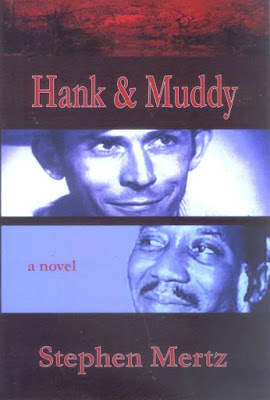
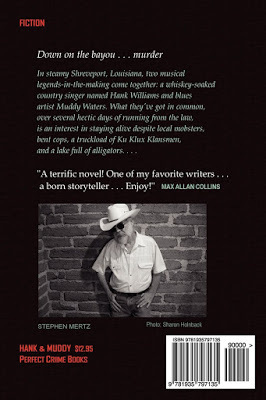 HANK AND MUDDY AND FAVORITE CHILDREN Writers often get asked, which one of your books is your favorite? The safe answer is to claim your books are like your children—you love them all equally. However, when applied to either children or books, this is a lie. Every child you raise has a different personality, as does every book you write—they all need love, but in varying degrees and varying ways. Those children who are the most difficult need our love the most. It is the same with books. You always love your child, but depending on their phase of maturity, you might not like them very much. Books are no different… I always say my favorite book is the one I’m writing next because it has all the promise of a child about to be born, hasn’t yet thrown a tantrum on the page, nor gone through the terrible twos, which is when you hit the difficult part of a manuscript—usually between page ten and ten pages before you can type The End. Still, of the books I have written, I do have favorites. Some of my books are more personal, some perhaps carry more of my soul than others. I love them all, even those I’ve had to beat into submission, but one or two are special… Recently, my writing pal Stephen Mertz stated, among his extensive output of novels, his favorite was Hank And Muddy—a novel in which he was able to use his writing skills to express many of his feelings about also being a musician, performing on the road, and a life he might have lived. Seeing an opportunity, I asked his permission to publish his thoughts on why Hank And Muddy is his favorite child…
HANK AND MUDDY AND FAVORITE CHILDREN Writers often get asked, which one of your books is your favorite? The safe answer is to claim your books are like your children—you love them all equally. However, when applied to either children or books, this is a lie. Every child you raise has a different personality, as does every book you write—they all need love, but in varying degrees and varying ways. Those children who are the most difficult need our love the most. It is the same with books. You always love your child, but depending on their phase of maturity, you might not like them very much. Books are no different… I always say my favorite book is the one I’m writing next because it has all the promise of a child about to be born, hasn’t yet thrown a tantrum on the page, nor gone through the terrible twos, which is when you hit the difficult part of a manuscript—usually between page ten and ten pages before you can type The End. Still, of the books I have written, I do have favorites. Some of my books are more personal, some perhaps carry more of my soul than others. I love them all, even those I’ve had to beat into submission, but one or two are special… Recently, my writing pal Stephen Mertz stated, among his extensive output of novels, his favorite was Hank And Muddy—a novel in which he was able to use his writing skills to express many of his feelings about also being a musician, performing on the road, and a life he might have lived. Seeing an opportunity, I asked his permission to publish his thoughts on why Hank And Muddy is his favorite child…
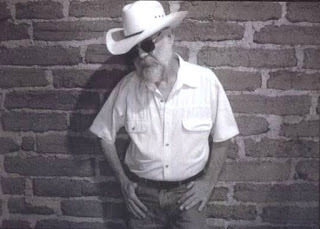 WRITING HANK AND MUDDY Stephen Mertz I knew I wanted to be either a writer or a musician. I was a working musician, blowing harp (as in harmonica) in Eagle Park Slim’s Mile High Blues Band—the house band at a black after hours club in Denver’s Five Points. From the 1930s to the 1950s, Five Points was considered the Harlem of the West, with bars and clubs where people like Duke Ellington and Billie Holiday played. However, by the 1960s, it had suffered the same demise as inner cities across the U.S. When I played there, Five Points was a rough part of town. Slim is a real deal St. Louis bluesman (who currently resides and works in Eugene, Oregon), and the Mile High Band was hot. I’ve got the tapes to prove it. The band’s gig was Thursdays through Saturdays, 11pm to 3am. The drummer and I were the only white boys in the place. I was living the life. Trouble was, I was beginning to gradually sell more of my writing to the smaller markets of the day. No bread to speak of, but I was establishing a presence. I’d wanted to be a writer since I was a kid. I could taste the dream of being a published novelist becoming a reality, that’s how close it was even though the rejections continued to outnumber the sales.
WRITING HANK AND MUDDY Stephen Mertz I knew I wanted to be either a writer or a musician. I was a working musician, blowing harp (as in harmonica) in Eagle Park Slim’s Mile High Blues Band—the house band at a black after hours club in Denver’s Five Points. From the 1930s to the 1950s, Five Points was considered the Harlem of the West, with bars and clubs where people like Duke Ellington and Billie Holiday played. However, by the 1960s, it had suffered the same demise as inner cities across the U.S. When I played there, Five Points was a rough part of town. Slim is a real deal St. Louis bluesman (who currently resides and works in Eugene, Oregon), and the Mile High Band was hot. I’ve got the tapes to prove it. The band’s gig was Thursdays through Saturdays, 11pm to 3am. The drummer and I were the only white boys in the place. I was living the life. Trouble was, I was beginning to gradually sell more of my writing to the smaller markets of the day. No bread to speak of, but I was establishing a presence. I’d wanted to be a writer since I was a kid. I could taste the dream of being a published novelist becoming a reality, that’s how close it was even though the rejections continued to outnumber the sales.
 I was also starting to realize life as musician was not exactly conducive to the discipline of schedule and routine necessary to produce fiction. An earlier conversation with the famous blues harp player, James Cotton, also lingered in my mind. I was in a band called Blue Tale Fly at the time, a bar band playing Allman Brothers and J. Geils covers and a few originals. We’d landed a four night gig as the opening act for Cotton at the old Rio Grande down by Denver’s rail yards. Cotton was a party animal. Plenty of drink and smoke and passing the time with small talk between sets. He’d just signed with Albert Grossman—Dylan’s manager—who had landed him a contract with Capitol. Star time! Except, Cotton added, for the last two years, he’d been on the road 50 weeks out of the year. That sunk into me and stayed. I’d only been living the life with Eagle Park Slim for 18 months and I was already starting to burn out. I like to entertain and socialize well enough, but like most writers, I am by nature a solitary soul. Then Don Pendleton stepped in to nudge me into my future with an offer to assist him in the writing of Mack Bolan novels (this was years before Don sold the Bolan franchise to Harlequin, where it flourished, scripted by a cadre of contract writers). For me, Don’s offer was the writing dream come true. No more smoky bars, bad food and crazy hours. I could sit at a keyboard and make a decent living. An apprenticeship! I could not say no, and so I said goodbye to Slim and the guys and to the musician’s life. I resettled on a country road near Don’s spread in Brown County, Indiana. Well, the Mack Bolan gig lasted for six months (not Don’s fault; we remained close friends until his passing), but in the process, I had acquired a lifelong taste for what is called the writing life. I’ve lived on back roads ever since, writing short fiction and novels which, I’m happy to say, have been published for the most part to favorable reviews and reader acceptance. And guess what? Turns out being a writer is not so different from being a musician. Sure, the work conditions are more comfortable, but it’s still all about hustling up the next gig, about finding an audience by striving to provide something worth their while.
I was also starting to realize life as musician was not exactly conducive to the discipline of schedule and routine necessary to produce fiction. An earlier conversation with the famous blues harp player, James Cotton, also lingered in my mind. I was in a band called Blue Tale Fly at the time, a bar band playing Allman Brothers and J. Geils covers and a few originals. We’d landed a four night gig as the opening act for Cotton at the old Rio Grande down by Denver’s rail yards. Cotton was a party animal. Plenty of drink and smoke and passing the time with small talk between sets. He’d just signed with Albert Grossman—Dylan’s manager—who had landed him a contract with Capitol. Star time! Except, Cotton added, for the last two years, he’d been on the road 50 weeks out of the year. That sunk into me and stayed. I’d only been living the life with Eagle Park Slim for 18 months and I was already starting to burn out. I like to entertain and socialize well enough, but like most writers, I am by nature a solitary soul. Then Don Pendleton stepped in to nudge me into my future with an offer to assist him in the writing of Mack Bolan novels (this was years before Don sold the Bolan franchise to Harlequin, where it flourished, scripted by a cadre of contract writers). For me, Don’s offer was the writing dream come true. No more smoky bars, bad food and crazy hours. I could sit at a keyboard and make a decent living. An apprenticeship! I could not say no, and so I said goodbye to Slim and the guys and to the musician’s life. I resettled on a country road near Don’s spread in Brown County, Indiana. Well, the Mack Bolan gig lasted for six months (not Don’s fault; we remained close friends until his passing), but in the process, I had acquired a lifelong taste for what is called the writing life. I’ve lived on back roads ever since, writing short fiction and novels which, I’m happy to say, have been published for the most part to favorable reviews and reader acceptance. And guess what? Turns out being a writer is not so different from being a musician. Sure, the work conditions are more comfortable, but it’s still all about hustling up the next gig, about finding an audience by striving to provide something worth their while.
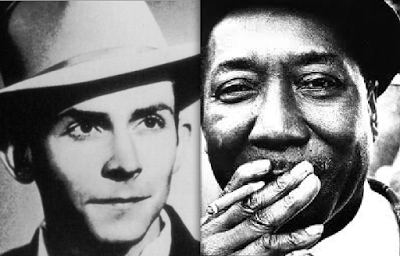 My novel, Hank And Muddy, is the account of a fictional meeting between two rough-and-tumble American music icons, whiskey-soaked Hank Williams and mojo man Muddy Waters, on a steamy summer night in Shreveport, Louisiana in 1952, and the misadventures that ensue. The title characters alternate as narrators. It’s a tale about music, race, sex and the other things uniting and dividing American society in 1952 and today. The a plot involves the Ku Klux Klan, crooked cops, the black underworld of Shreveport in that era, G-men and commies, a bank robber’s free-spirited daughter, and a quest for Hank’s missing songbook. These days I perform around Tucson now and then, and finally, I’ve written a novel about the music I love. Who says you can’t have it all? Just wish I’d figured that out a long time ago...
My novel, Hank And Muddy, is the account of a fictional meeting between two rough-and-tumble American music icons, whiskey-soaked Hank Williams and mojo man Muddy Waters, on a steamy summer night in Shreveport, Louisiana in 1952, and the misadventures that ensue. The title characters alternate as narrators. It’s a tale about music, race, sex and the other things uniting and dividing American society in 1952 and today. The a plot involves the Ku Klux Klan, crooked cops, the black underworld of Shreveport in that era, G-men and commies, a bank robber’s free-spirited daughter, and a quest for Hank’s missing songbook. These days I perform around Tucson now and then, and finally, I’ve written a novel about the music I love. Who says you can’t have it all? Just wish I’d figured that out a long time ago...
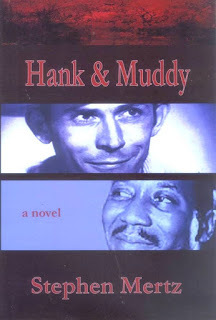 HANK AND MUDDY In steamy Shreveport, Louisiana, two musical legends-in-the-making come together: a whiskey-soaked country singer named Hank Williams and blues artist Muddy Waters. What they've got in common over several hectic days of drinking, singing and whoring is an interest in staying alive despite local mobsters, bent cops, and a truckload of Ku Klux Klansmen. Then there's the bank robber's daughter... FOR MORE ON HANK AND MUDDY CLICK HERE FOR MORE ON STEPHEN MERTZ CLICK HERE
HANK AND MUDDY In steamy Shreveport, Louisiana, two musical legends-in-the-making come together: a whiskey-soaked country singer named Hank Williams and blues artist Muddy Waters. What they've got in common over several hectic days of drinking, singing and whoring is an interest in staying alive despite local mobsters, bent cops, and a truckload of Ku Klux Klansmen. Then there's the bank robber's daughter... FOR MORE ON HANK AND MUDDY CLICK HERE FOR MORE ON STEPHEN MERTZ CLICK HERE
Published on May 30, 2016 10:40
May 18, 2016
INTERROGATING AUTHOR KATHY BENNETT
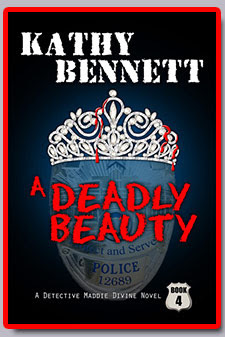 DEADLY PROSE AND BLEEDING PAGESINTERROGATING AUTHOR KATHY BENNETT Kathy Bennett served twenty-nine years with the Los Angeles Police Department—eight as a civilian employee and twenty-one as a sworn police officer. Thriving for the majority of her career roaring from call to call in a patrol car, she also worked assignments as a firearms instructor, a crime analyst in the War Room, a field-training officer, a senior lead officer, and an undercover officer for various assignments. She was named Officer of the Year in 1997.
DEADLY PROSE AND BLEEDING PAGESINTERROGATING AUTHOR KATHY BENNETT Kathy Bennett served twenty-nine years with the Los Angeles Police Department—eight as a civilian employee and twenty-one as a sworn police officer. Thriving for the majority of her career roaring from call to call in a patrol car, she also worked assignments as a firearms instructor, a crime analyst in the War Room, a field-training officer, a senior lead officer, and an undercover officer for various assignments. She was named Officer of the Year in 1997.
 In 2011, Kathy’s first novel, A Deadly Dozen Roses—featuring Los Angeles Police Officer Jade Donovan—hit the digital bookshelves. Since then, Kathy has written four entries in her bestselling LAPD Detective Maddie Divine series. A Deadly Blessing, the first book in the series, was chosen as a Best Book of 2012 by Barnes and Noble. The fourth Detective Maddie Divine novel, A Deadly Beauty, was released in March 2016 and is quickly becoming a bestselling police procedural on Amazon.
An interrogator should never ask compound, complex questions. They can be confusing and can lead to bad things—like the invoking of rights. But, as she is under suspicion of writing Deadly dangerous prose, Kathy does not have the right to remain silent…So, I’m going to run the risk of asking some pesky compound, complex questions and let Kathy to have free range in her answers…
Oh, dear…Free range in my answers…Hmm, I might get into a lot of trouble.
Were you still ‘on the job’ when you started writing, and do you consider yourself a cop who is a writer or a writer who is a cop (even though you are retired, we know there is no such thing as an ex-Marine or an ex-cop)…Was there a defining moment of separation between cop and writer?
In 2011, Kathy’s first novel, A Deadly Dozen Roses—featuring Los Angeles Police Officer Jade Donovan—hit the digital bookshelves. Since then, Kathy has written four entries in her bestselling LAPD Detective Maddie Divine series. A Deadly Blessing, the first book in the series, was chosen as a Best Book of 2012 by Barnes and Noble. The fourth Detective Maddie Divine novel, A Deadly Beauty, was released in March 2016 and is quickly becoming a bestselling police procedural on Amazon.
An interrogator should never ask compound, complex questions. They can be confusing and can lead to bad things—like the invoking of rights. But, as she is under suspicion of writing Deadly dangerous prose, Kathy does not have the right to remain silent…So, I’m going to run the risk of asking some pesky compound, complex questions and let Kathy to have free range in her answers…
Oh, dear…Free range in my answers…Hmm, I might get into a lot of trouble.
Were you still ‘on the job’ when you started writing, and do you consider yourself a cop who is a writer or a writer who is a cop (even though you are retired, we know there is no such thing as an ex-Marine or an ex-cop)…Was there a defining moment of separation between cop and writer?
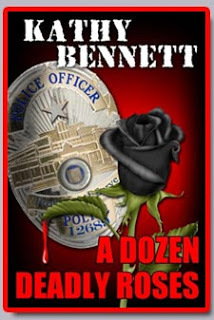 I started writing seriously in 1998 while I was still on the job. I thought I was going to be a romance writer, but when my critique partner would read my work, she would say, "I see plenty of mystery here, but where's the romance?" I'd wave my hand and say, "I'll throw that in later." After many of these discussions, I finally figured out that maybe I wasn't a romance writer. In regards to separating the cop and the writer, I don't think I've made the break. I like to brand my books as Authentic Crime…Arresting Stories, so I try to be as realistic as I can. The longer I'm retired, the tougher it gets. If I need info about current procedures, I contact friends who are still on the job—although, that gets a little harder every year because many of the people I know have also retired or are getting ready to retire.
Who were your original writing influences…How aware were you of other cop writers when you first put the metaphorical pen to paper?
I've had a lot of writing influences in my life, often different ones depending on where I was in my writing career. The writer who had biggest influence in my writing career was probably Jackie Collins. The first book I read of hers was Hollywood Wives. She wrote in rotating points of view. I loved that style, and I've adopted it in my own work. I’ve also read a lot in the mystery/thriller/suspense genre. In actuality, I think every writer I've read has had an influence whether I'm conscious of their impact or not. The only cop writer I was aware of when I started writing was Joseph Wambaugh, whom I love. I learned about another writer who was a cop when he came and spoke at one of my romance groups in Orange County. His name was Paul Bishop, and I bought, devoured, and loved his Fay Croaker series. We're good buddies now.
Ha! Quit trying to get on my good side…I don’t have one…You aren’t getting out of this interrogation that easily…What prompted you to change main characters from Jade Donovan to Maddie Divine…How did Maddie take over as your main series character and Jade get demoted to cameo or secondary appearances?
I started writing seriously in 1998 while I was still on the job. I thought I was going to be a romance writer, but when my critique partner would read my work, she would say, "I see plenty of mystery here, but where's the romance?" I'd wave my hand and say, "I'll throw that in later." After many of these discussions, I finally figured out that maybe I wasn't a romance writer. In regards to separating the cop and the writer, I don't think I've made the break. I like to brand my books as Authentic Crime…Arresting Stories, so I try to be as realistic as I can. The longer I'm retired, the tougher it gets. If I need info about current procedures, I contact friends who are still on the job—although, that gets a little harder every year because many of the people I know have also retired or are getting ready to retire.
Who were your original writing influences…How aware were you of other cop writers when you first put the metaphorical pen to paper?
I've had a lot of writing influences in my life, often different ones depending on where I was in my writing career. The writer who had biggest influence in my writing career was probably Jackie Collins. The first book I read of hers was Hollywood Wives. She wrote in rotating points of view. I loved that style, and I've adopted it in my own work. I’ve also read a lot in the mystery/thriller/suspense genre. In actuality, I think every writer I've read has had an influence whether I'm conscious of their impact or not. The only cop writer I was aware of when I started writing was Joseph Wambaugh, whom I love. I learned about another writer who was a cop when he came and spoke at one of my romance groups in Orange County. His name was Paul Bishop, and I bought, devoured, and loved his Fay Croaker series. We're good buddies now.
Ha! Quit trying to get on my good side…I don’t have one…You aren’t getting out of this interrogation that easily…What prompted you to change main characters from Jade Donovan to Maddie Divine…How did Maddie take over as your main series character and Jade get demoted to cameo or secondary appearances?
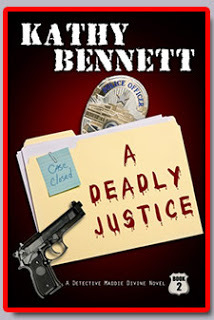 My very first published book was a romantic suspense story featuring LAPD Detective Jade Donovan. I intended the book to be a standalone story. Many writer friends said mystery readers loved book series. I agreed, but I thought I was done with Jade, so I created a new character, LAPD Detective Maddie Divine. However, readers loved Jade so much they begged me to bring her back. She appears briefly in Maddie's first book, A Deadly Blessing, and then Jade and Maddie are partners in the second book in the series, A Deadly Justice. I haven't ruled out bringing Jade back in a different series in a different location sometime in the future.
How much of your own experiences as a police officer gets on the page—is authenticity more important than story?
I like to call myself Doctor Frankenstein because I take bits and pieces of incidents, people, and my own life experiences, and weave them into my stories. I do my best to stay true to the policies and procedures of the LAPD. However, I write fiction, so I often have officers making moral decisions that are a figment of my imagination. I know I have a quite few current or former police officers from various agencies around the world who read my books. They love my stories and applaud the fact I get the departmental politics spot on. I think police politics is a phenomenon that translates well, no matter the police agency.
How did you come to embrace the brave new world of e-publishing and did you first attempt the legacy publishing route (traditional NY publishers)?
I was about to retire from the LAPD, and I was looking for an agent. I began to hear a lot about e-publishing and the fact you could do it yourself. I felt my first book, A Dozen Deadly Roses, was a good story and people would want to read it. I decided to publish it myself as an e-book. Fortunately, it took off in a big way—making the list of Top 25 Mystery—Suspense Booksat both Amazon and Barnes & Noble and staying there for weeks.
My very first published book was a romantic suspense story featuring LAPD Detective Jade Donovan. I intended the book to be a standalone story. Many writer friends said mystery readers loved book series. I agreed, but I thought I was done with Jade, so I created a new character, LAPD Detective Maddie Divine. However, readers loved Jade so much they begged me to bring her back. She appears briefly in Maddie's first book, A Deadly Blessing, and then Jade and Maddie are partners in the second book in the series, A Deadly Justice. I haven't ruled out bringing Jade back in a different series in a different location sometime in the future.
How much of your own experiences as a police officer gets on the page—is authenticity more important than story?
I like to call myself Doctor Frankenstein because I take bits and pieces of incidents, people, and my own life experiences, and weave them into my stories. I do my best to stay true to the policies and procedures of the LAPD. However, I write fiction, so I often have officers making moral decisions that are a figment of my imagination. I know I have a quite few current or former police officers from various agencies around the world who read my books. They love my stories and applaud the fact I get the departmental politics spot on. I think police politics is a phenomenon that translates well, no matter the police agency.
How did you come to embrace the brave new world of e-publishing and did you first attempt the legacy publishing route (traditional NY publishers)?
I was about to retire from the LAPD, and I was looking for an agent. I began to hear a lot about e-publishing and the fact you could do it yourself. I felt my first book, A Dozen Deadly Roses, was a good story and people would want to read it. I decided to publish it myself as an e-book. Fortunately, it took off in a big way—making the list of Top 25 Mystery—Suspense Booksat both Amazon and Barnes & Noble and staying there for weeks.
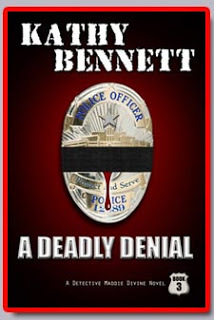 The next year, I released my second book, A Deadly Blessing, which was the first book in the Maddie Divine series. That book also climbed the lists, and Barnes & Noble chose it as one of their Best Nook Books for 2012. The book also caught the attention of one of the most respected agents in the country. He now represents me.
How do you approach the marketing of your books…What has worked for you…What hasn’t…How did you pull your website together…How do you prepare for the launch of a new title?
I've had my website since 2008. I knew from the beginning how I wanted my website to look, and it hasn't changed too much over the years. I've used Facebook for quite some time. I have my author page, and then I have a closed Facebook group for my SWAT team. The SWAT members are loyal readers who are my Spread the Word Allover Team. They tell their friends and others about my books. I also tweet on Twitter, but I'm not a huge fan. With my most recent book, A Deadly Beauty, I had the book available for preorder for about two weeks. I did some Facebook posts and a couple of ads for the launch. I also used my newsletter to let my regular readers know about the new book.
The next year, I released my second book, A Deadly Blessing, which was the first book in the Maddie Divine series. That book also climbed the lists, and Barnes & Noble chose it as one of their Best Nook Books for 2012. The book also caught the attention of one of the most respected agents in the country. He now represents me.
How do you approach the marketing of your books…What has worked for you…What hasn’t…How did you pull your website together…How do you prepare for the launch of a new title?
I've had my website since 2008. I knew from the beginning how I wanted my website to look, and it hasn't changed too much over the years. I've used Facebook for quite some time. I have my author page, and then I have a closed Facebook group for my SWAT team. The SWAT members are loyal readers who are my Spread the Word Allover Team. They tell their friends and others about my books. I also tweet on Twitter, but I'm not a huge fan. With my most recent book, A Deadly Beauty, I had the book available for preorder for about two weeks. I did some Facebook posts and a couple of ads for the launch. I also used my newsletter to let my regular readers know about the new book.
 Do you attend mystery conventions like Bouchercon or Left Coast Crime...Did you attend writing conferences when you were first starting out…Do you attend them now as a guest speaker…Do they help?
I've attended Left Coast Crime, Bouchercon, Thrillerfest, and Romance Writers of America conferences amongst others. I've been a guest speaker at all but Thrillerfest. I think conferences have a small effect on getting your name out there, however, I believe the real benefit is connecting with the other writers and soaking up the energy. Conferences can be expensive, and I'm finding more and more authors are cutting back on conventions so they can concentrate on getting their next book out—which, in my opinion, is the best sales tool of all.
As a writer are you an draftsman (meticulously plotting and outlining) or a horticulturist (planting a plot seed, watering it, and waiting for your story to grow as you write)?
Do you attend mystery conventions like Bouchercon or Left Coast Crime...Did you attend writing conferences when you were first starting out…Do you attend them now as a guest speaker…Do they help?
I've attended Left Coast Crime, Bouchercon, Thrillerfest, and Romance Writers of America conferences amongst others. I've been a guest speaker at all but Thrillerfest. I think conferences have a small effect on getting your name out there, however, I believe the real benefit is connecting with the other writers and soaking up the energy. Conferences can be expensive, and I'm finding more and more authors are cutting back on conventions so they can concentrate on getting their next book out—which, in my opinion, is the best sales tool of all.
As a writer are you an draftsman (meticulously plotting and outlining) or a horticulturist (planting a plot seed, watering it, and waiting for your story to grow as you write)?
 Every book I've written was written in a different way. In the book I'm currently writing, I started out with half the book outlined. Then about a quarter of the way in, the characters started doing their own thing. I'm now writing by the seat of my pants. It makes the process harder and longer. I keep saying I'm going to plot the whole book, but this is my sixth book, and it still hasn't happened.
What are your writing goals...Where do you see yourself as a writer ten years from now—still in the mystery genre or branching out?
I think I'll always be writing in the mystery genre. I love police work, and I like creating the façade of people's lives and deciding how and why they do the things they do. In ten years, I hope people still love what I write and that I'm around to keep writing those stories.
Lastly, a question about law enforcement... Things have changed since you and I were on the job...What do you see as the strengths and failures of law enforcement in today’s critically charged atmosphere...If I snap my fingers and make you LAPD’s Chief of Police, what would be the first things you would do?
Every book I've written was written in a different way. In the book I'm currently writing, I started out with half the book outlined. Then about a quarter of the way in, the characters started doing their own thing. I'm now writing by the seat of my pants. It makes the process harder and longer. I keep saying I'm going to plot the whole book, but this is my sixth book, and it still hasn't happened.
What are your writing goals...Where do you see yourself as a writer ten years from now—still in the mystery genre or branching out?
I think I'll always be writing in the mystery genre. I love police work, and I like creating the façade of people's lives and deciding how and why they do the things they do. In ten years, I hope people still love what I write and that I'm around to keep writing those stories.
Lastly, a question about law enforcement... Things have changed since you and I were on the job...What do you see as the strengths and failures of law enforcement in today’s critically charged atmosphere...If I snap my fingers and make you LAPD’s Chief of Police, what would be the first things you would do?
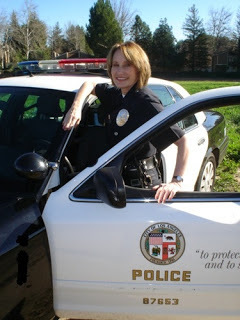 I’m not sure the ills of law enforcement can be cured from within the police department alone. I believe society, as a whole, has to change and understand how dangerous and hard police work can be. Like any other profession, police agencies have their share of bad apples, bad decisions, and bad accidents. I think much of society has lost respect for law enforcement officers. But that doesn't mean people should feel entitled to make it open season on police officers. Most of the officers I worked with spent their entire career trying to make the City of Los Angeles a better place to live and many have died pursuing that goal. With the crime rate going up, police agencies need to get back to the basics. The patrol officers you see on the street every day are the backbone of the police department, and its mission. If someone made me the chief, I would put all able-bodied patrol officers back into basic cars—aka regular patrol. I would get the city to hire civilians to fill the civilian jobs many sworn officers are currently doing. Sworn officers who couldn't work in the field (for whatever reason) would be assigned to non-field assignments, such as (but not limited to) the front desk, Community Relations, Youth Programs, and Communications Division until they were able to work the field again. That would be my first day. Now, aren't you sorry you made me the chief?
Thx to Kathy Bennett for hanging out and letting me pepper her with questions. Be sure to check Kathy out on Amazon and follow the links below for more information on her books…
I’m not sure the ills of law enforcement can be cured from within the police department alone. I believe society, as a whole, has to change and understand how dangerous and hard police work can be. Like any other profession, police agencies have their share of bad apples, bad decisions, and bad accidents. I think much of society has lost respect for law enforcement officers. But that doesn't mean people should feel entitled to make it open season on police officers. Most of the officers I worked with spent their entire career trying to make the City of Los Angeles a better place to live and many have died pursuing that goal. With the crime rate going up, police agencies need to get back to the basics. The patrol officers you see on the street every day are the backbone of the police department, and its mission. If someone made me the chief, I would put all able-bodied patrol officers back into basic cars—aka regular patrol. I would get the city to hire civilians to fill the civilian jobs many sworn officers are currently doing. Sworn officers who couldn't work in the field (for whatever reason) would be assigned to non-field assignments, such as (but not limited to) the front desk, Community Relations, Youth Programs, and Communications Division until they were able to work the field again. That would be my first day. Now, aren't you sorry you made me the chief?
Thx to Kathy Bennett for hanging out and letting me pepper her with questions. Be sure to check Kathy out on Amazon and follow the links below for more information on her books…
 A DEADLY BEAUTY Two women. Two very different deaths. One beauty pageant in common. LAPD Detective Maddie Divine must search for the truth amidst secrets, lies and the scams of Hollywood. Her investigation intensifies when news breaks that two young pageant contestants have vanished. When Maddie uncovers a shocking secret it's clear she's searching for two different killers, not one. In a desperate race against time, Maddie leads an urgent manhunt to save each young beauty before it's too late. TO READ AN EXCERPT CLICK HERE FOR MORE ABOUT A DEADLY BEAUTY CLICK HERE FOR MORE ABOUT KATHY BENNETT AND HER BOOKS CLICK HERE
A DEADLY BEAUTY Two women. Two very different deaths. One beauty pageant in common. LAPD Detective Maddie Divine must search for the truth amidst secrets, lies and the scams of Hollywood. Her investigation intensifies when news breaks that two young pageant contestants have vanished. When Maddie uncovers a shocking secret it's clear she's searching for two different killers, not one. In a desperate race against time, Maddie leads an urgent manhunt to save each young beauty before it's too late. TO READ AN EXCERPT CLICK HERE FOR MORE ABOUT A DEADLY BEAUTY CLICK HERE FOR MORE ABOUT KATHY BENNETT AND HER BOOKS CLICK HERE
Published on May 18, 2016 21:18
AUTHOR APPRECIATION MONTH ~ PART 2
 AUTHOR APPRECIATION MONTH ~ PART 2
AUTHOR APPRECIATION MONTH ~ PART 2Continuing to celebrate May as author appreciation month, I'm putting a quick spotlight on a variety of authors who I appreciate whose novels are worth your hard earned book dollars. I’m focusing on both current writers who are flying under your radar, as well as some ghosts from the past who deserve a revival...
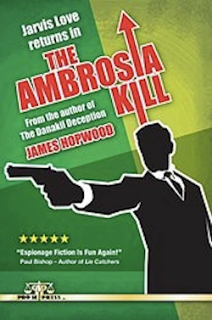 Under the pseudonym James Hopwood, Australian David Foster has put the fun back in espionage. His three novels (The Librio Defection, The Danakil Deception, and The Ambrosia Kill) featuring neophyte British agent Jarvis Love of the Global Intelligence Network, have given new life to the espionage genre. Tearing spy fiction out from under dreary, shadowy chess game world of John le Carré, and returns it to the cool vibe of the swinging sixties. The not quite suave and sophisticated Jarvis Love infiltrates villains’ lairs, takes on evil megalomaniacs, thwarts plans for world domination, is pursued by beautiful women, and keeps himself ready for hair-breadth escapes. While retro in flavor, the Jarvis Love books also maintain a modern sensibility which breaks new ground for this style of spy thriller.
Under the pseudonym James Hopwood, Australian David Foster has put the fun back in espionage. His three novels (The Librio Defection, The Danakil Deception, and The Ambrosia Kill) featuring neophyte British agent Jarvis Love of the Global Intelligence Network, have given new life to the espionage genre. Tearing spy fiction out from under dreary, shadowy chess game world of John le Carré, and returns it to the cool vibe of the swinging sixties. The not quite suave and sophisticated Jarvis Love infiltrates villains’ lairs, takes on evil megalomaniacs, thwarts plans for world domination, is pursued by beautiful women, and keeps himself ready for hair-breadth escapes. While retro in flavor, the Jarvis Love books also maintain a modern sensibility which breaks new ground for this style of spy thriller.And don’t miss Foster’s three hard-hitting pulp tales of boxing and mayhem written under his Jack Tunney pseudonym—King Of The Outback, Rumble In The Jungle, and The Iron Fists Of Ned Kelley...
For more on David Foster CLICK HERE
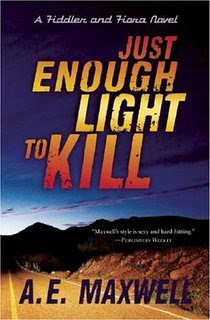 Following on the heels of Robert Parker’s Spenser novels—which brought the ailing private eye genre out from under Chandler’s shadow to explode across the literary landscape again—A. E. Maxwell’s Just Another Day in Paradise rose like a leviathan through the many also rans trying to cash in on the ‘80s hardboiled revival. A. E. Maxwell is a shared pseudonym for Evan and Ann Maxwell—Ann being a bestselling romance writer under her own pseudonym, Elizabeth Lowell.
Following on the heels of Robert Parker’s Spenser novels—which brought the ailing private eye genre out from under Chandler’s shadow to explode across the literary landscape again—A. E. Maxwell’s Just Another Day in Paradise rose like a leviathan through the many also rans trying to cash in on the ‘80s hardboiled revival. A. E. Maxwell is a shared pseudonym for Evan and Ann Maxwell—Ann being a bestselling romance writer under her own pseudonym, Elizabeth Lowell.While reminiscent of the tough early Spenser novels (not a bad thing), the Maxwell’s eight novels featuring Fiddler and his paramour Fiora still reign as one of the most smoothly written and engaging series to come out of the private eye surge. The plots are high concept while remaining believable; Fiddler and Fiora are complex, relatable characters; and there is enough moral ambiguity to keep things on a rollercoaster—Just Enough Light To Kill is my favorite in the series…
For more on A. E. Maxwell CLICK HERE
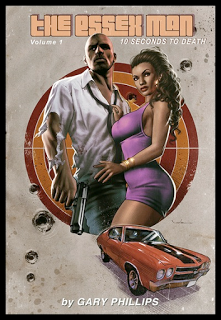 Part Shaft and part Batman sans the costume, Gary Phillips’ Essex Man is one of the many characters who elevate Phillips to the forefront of the New Pulp movement. In the spirit of full disclosure, Gary is a good friend whose opinions and real world savvy I admire. He is an activist at heart, has a voice James Earl Jones would envy, and looks scary as hell until he smiles and you see the fun and goodness behind the façade. I highlight him here not because he is a friend, but because his writing demands a wider audience.
Part Shaft and part Batman sans the costume, Gary Phillips’ Essex Man is one of the many characters who elevate Phillips to the forefront of the New Pulp movement. In the spirit of full disclosure, Gary is a good friend whose opinions and real world savvy I admire. He is an activist at heart, has a voice James Earl Jones would envy, and looks scary as hell until he smiles and you see the fun and goodness behind the façade. I highlight him here not because he is a friend, but because his writing demands a wider audience. Part noir, part blaxploitation, part pulp, all wrapped tight in Chester Himes style cool, there are deeper layers to everything Phillips writes. His hardboiled private eye series featuring Ivan Monk (including Bad Night Is Fallingand Perdition U.S.A.) is the place to start before moving on to his tales featuring Martha Chainey—a shadowy ex-showgirl bedeviling the Vegas mob (Shooter’s Point)—and his tough guys McBleak, Noc Brenner, and Luke Warfield in Three The Hard Way…
For more on Gary Phillips CLICK HERE
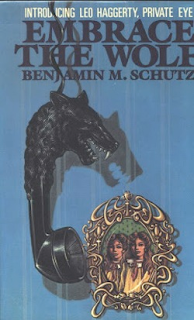 Another hardboiled series to hit the bookshelves in the wake of the success of Robert Parker’s Spenser novels was Washington D.C. private eye Leo Haggerty. Psychologist turned author Benjamin Schutz threw together all the Parker/Spenser ingredients, yet through strong writing also managed to give his series its own edge.
Another hardboiled series to hit the bookshelves in the wake of the success of Robert Parker’s Spenser novels was Washington D.C. private eye Leo Haggerty. Psychologist turned author Benjamin Schutz threw together all the Parker/Spenser ingredients, yet through strong writing also managed to give his series its own edge.Leo Haggerty—a jockish/renaissance-type hero obsessed with moral dilemmas—is slightly harder and more cynical than Spencer. Arnie Kendall has the Hawk role as the unstoppable, slightly psychotic, but loyal sidekick. And Samantha Clayton has the insufferable Susan Silverman part as the smart/sexy girlfriend who helps the hero understand himself. Schutz described the relationship between Leo and Arnie as imagining Lew Archer with Mike Hammer for a partner.
The first novel in the series, Embrace the Wolf, has a chilling opening scene with a father receiving a phone call with the recorded voices of his twin daughters. Kidnapped five years earlier at five years old, all efforts to find any trace of them ended in failure. After the brief tape is played of his daughters’ imploring voices, a male voice comes on the phone saying, “I still have them,” and hangs up. When the father goes off on a rampage to find his daughter, the mother—who has long given up her daughters for dead—hires Haggerty to stop her husband before she loses him as well.
While the six novel in this series owe a debt to Parker/Spenser they are powerful and well written in their own right and eventually come to stand on their own.
For more on Benjamin Schutz CLICK HERE
Author John Whitlatch is an absolute enigma. Between 1969 and 1976, Whitlatch ground out eleven novels published by Pocket Books, each filled with pulp-style action. While The Judas Goat was a WWII Dirty Dozen-style action thriller, and The Iron Shirt was a traditional western, his other novels all fell into the crime and adventure genre—most often with a lone man up against everything including motorcycle gangs, political conspiracies, and corrupt third world regimes.
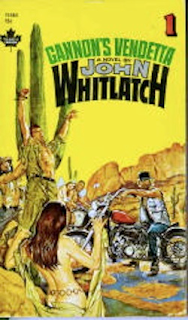 Whitlatch’s titles were catchy (Cory’s Losers, Frank T’s Plan, Stunt Man’s Holiday, etc.), but the lurid paperback original covers made each title immediately collectible. Blazing primary colors set off action illustrations torn from the Men’s Adventure magazines of the day. While Whitlatch was a more than competent, if straightforward, writer, it is the covers which make these paperback originals highly collectable.
Whitlatch’s titles were catchy (Cory’s Losers, Frank T’s Plan, Stunt Man’s Holiday, etc.), but the lurid paperback original covers made each title immediately collectible. Blazing primary colors set off action illustrations torn from the Men’s Adventure magazines of the day. While Whitlatch was a more than competent, if straightforward, writer, it is the covers which make these paperback originals highly collectable.My introduction to Whitlatch came through his second published title, Morgan’s Rebellion. This was a great adventure tale with our California hero being falsely imprisoned in Central America. With only his archery skills to help him, he must escape and overthrow the corrupt regime before chasing his wife and his business partner down the revenge trail—Oh, yeah!
To check out the stunning Whitlatch paperback covers CLICK HERE
For more on John Whitlatch CLICK HERE
As I stated in last week’s column, writing can be a lonely trade...During the Author Appreciation Month of May make an effort to show admiration for your favorite authors by leaving a review on Amazon or Goodreads. Let them know their efforts are reaching and entertaining readers...
Published on May 18, 2016 19:44
AUTHOR APPRECIATION MONTH ~ PART 1
 AUTHOR APPRECIATION MONTH ~ PART 1 May is author appreciation month. To celebrate, I'm sharing the lowdown on a number of authors who I appreciate and whose works merit more attention. Some are current writers deserving of a far wider audience, while others are old favorites who have undeservedly fallen out of the limelight...
AUTHOR APPRECIATION MONTH ~ PART 1 May is author appreciation month. To celebrate, I'm sharing the lowdown on a number of authors who I appreciate and whose works merit more attention. Some are current writers deserving of a far wider audience, while others are old favorites who have undeservedly fallen out of the limelight...
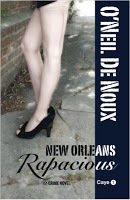 First up, retired New Orleans homicide detective, O'Neil De Noux. O’Neil’s debut series, featuring NOPD homicide detective Dino LaStanza, is top notch—Start with Grim Reaper. However, my favorite among O’Neil’s characters is 1940s New Orleans private eye Lucien Caye. The Caye tales are atmospheric, dangerous, and engrossing. Caye is my favorite PI—start with New Orleans Rapacious... For More on O’Neil De Noux CLICK HERE
First up, retired New Orleans homicide detective, O'Neil De Noux. O’Neil’s debut series, featuring NOPD homicide detective Dino LaStanza, is top notch—Start with Grim Reaper. However, my favorite among O’Neil’s characters is 1940s New Orleans private eye Lucien Caye. The Caye tales are atmospheric, dangerous, and engrossing. Caye is my favorite PI—start with New Orleans Rapacious... For More on O’Neil De Noux CLICK HERE
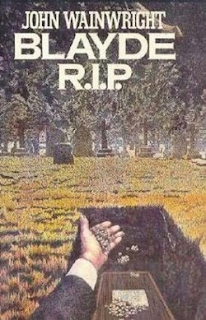 British cop turned author John Wainwright's prolific output of mysteries and psychological thrillers from the '60s through the late '80s is extensive. Each of his books are solid reads with many making the jump to great reads. It is a crime he isn't better remembered today—Track down The Tenth Interview, Brainwash, The Ride, or the brilliant Blade RIP... For more on John Wainwright CLICK HERE Eric Beetner is the man leading the new wave of hardboiled writers. He is quite possibly the best new writer you’ve never heard of. His two Fight Card novels, Split Decision and A Mouthful of Blood, are perfect examples of what Fight Card was trying to accomplish.
British cop turned author John Wainwright's prolific output of mysteries and psychological thrillers from the '60s through the late '80s is extensive. Each of his books are solid reads with many making the jump to great reads. It is a crime he isn't better remembered today—Track down The Tenth Interview, Brainwash, The Ride, or the brilliant Blade RIP... For more on John Wainwright CLICK HERE Eric Beetner is the man leading the new wave of hardboiled writers. He is quite possibly the best new writer you’ve never heard of. His two Fight Card novels, Split Decision and A Mouthful of Blood, are perfect examples of what Fight Card was trying to accomplish.
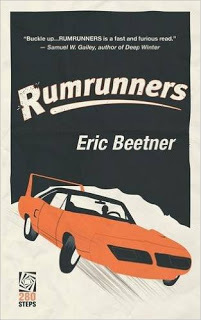 Recently, Blasted Heath published a new Beetner novel, Run For The Money, which teeters on the top of my to be read pile. However, my favorite Beetner novel is Rumrunners, a prime example of what he does best—full pedal to the metal, hard-hitting action. Another hot Beetner read is The Devil Wants Me Dead. You want crime? You want nasty, low down, desperate characters and wicked women? Then get you some Beetner now... For more on Eric Beetner CLICK HERE Bill Knox began his writing career as a Glasgow journalist at sixteen—tackling the positions of motoring correspondent, crime reporter, and news editor. He became well known to Scottish television viewers for his twelve years as the writer and presenter for police liaison program Crime Desk.
Recently, Blasted Heath published a new Beetner novel, Run For The Money, which teeters on the top of my to be read pile. However, my favorite Beetner novel is Rumrunners, a prime example of what he does best—full pedal to the metal, hard-hitting action. Another hot Beetner read is The Devil Wants Me Dead. You want crime? You want nasty, low down, desperate characters and wicked women? Then get you some Beetner now... For more on Eric Beetner CLICK HERE Bill Knox began his writing career as a Glasgow journalist at sixteen—tackling the positions of motoring correspondent, crime reporter, and news editor. He became well known to Scottish television viewers for his twelve years as the writer and presenter for police liaison program Crime Desk.
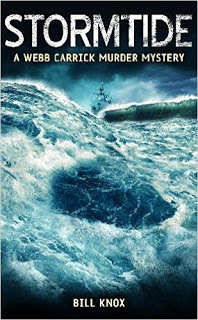 Knox began writing crime novels in the 1950s. Because of his prolific output, he used many pseudonyms—mostly for the American editions of his novels—including Michael Kirk, Robert MacLeod, and Noah Webster. He published over fifty crime novels, was translated into ten languages, and had worldwide sales in excess of four million copies. His best known books are the twenty-five titles featuring Scottish police detectives Thane and Moss—start with Rally To Kill, Draw Batons, or The Tallyman. While Knox’s Thane and Moss police procedural series received deserved attention, I prefer his fifteen novels spotlighting Webb Carrick of Her Majesty’s Fishery Protection Service. I was constantly amazed at how many solid plots Knox could build around a fish detective. To top it off, Carrick is a real man of action who leads his shipmates from the bow of the investigation, not from behind a desk at the stern—Check out Stormtide, Bombship, and Hellspout... For more on Bill Knox CLICK HERE Wayne D. Dundee is a writer who can turn his hand to any genre and deliver a rollicking tale. He turns genres upside down, shaking out all the clichés and tossing them away. A true wordslinger, is novels always break new ground in unexpected ways, often providing startling and satisfying twists—Look out for A Wide Spot In The Road.
Knox began writing crime novels in the 1950s. Because of his prolific output, he used many pseudonyms—mostly for the American editions of his novels—including Michael Kirk, Robert MacLeod, and Noah Webster. He published over fifty crime novels, was translated into ten languages, and had worldwide sales in excess of four million copies. His best known books are the twenty-five titles featuring Scottish police detectives Thane and Moss—start with Rally To Kill, Draw Batons, or The Tallyman. While Knox’s Thane and Moss police procedural series received deserved attention, I prefer his fifteen novels spotlighting Webb Carrick of Her Majesty’s Fishery Protection Service. I was constantly amazed at how many solid plots Knox could build around a fish detective. To top it off, Carrick is a real man of action who leads his shipmates from the bow of the investigation, not from behind a desk at the stern—Check out Stormtide, Bombship, and Hellspout... For more on Bill Knox CLICK HERE Wayne D. Dundee is a writer who can turn his hand to any genre and deliver a rollicking tale. He turns genres upside down, shaking out all the clichés and tossing them away. A true wordslinger, is novels always break new ground in unexpected ways, often providing startling and satisfying twists—Look out for A Wide Spot In The Road.
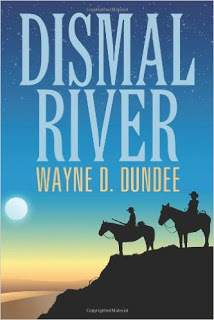 Dundee made his mark originally with his private eye Joe Hannibal tales, which were nominated for an Edgar, an Anthony, and six Shamus Awards—Track down Blade of the Tiger or The Brutal Ballet. Dundee also founded —and was the original editor—Hardboiled Magazine, which kept the flame of hardboiled fiction burning during a time when its flame was flickering. Most recently, Dundee has taken the western genre by storm, receiving three Peacemaker Awards from Western Fictioneers—So, get your spurs on for Dismal River, This Old Star, or Quick Hands... For more on Wayne D. Dundee CLICK HERE Scottish author Gerald Hammond was prolific writer with over seventy published novels. His last title, The Unkindest Cut, was published in 2012. His two popular mystery series characters, gunsmith Keith Calder and Three Oaks dog kennel owner John Cunningham, allowed Gerald to create stories in which he could indulge his passions for guns, dogs, bird hunting, fly fishing, and all things outdoors in the Scottish countryside—Look for Dead Game and Dog In The Dark.
Dundee made his mark originally with his private eye Joe Hannibal tales, which were nominated for an Edgar, an Anthony, and six Shamus Awards—Track down Blade of the Tiger or The Brutal Ballet. Dundee also founded —and was the original editor—Hardboiled Magazine, which kept the flame of hardboiled fiction burning during a time when its flame was flickering. Most recently, Dundee has taken the western genre by storm, receiving three Peacemaker Awards from Western Fictioneers—So, get your spurs on for Dismal River, This Old Star, or Quick Hands... For more on Wayne D. Dundee CLICK HERE Scottish author Gerald Hammond was prolific writer with over seventy published novels. His last title, The Unkindest Cut, was published in 2012. His two popular mystery series characters, gunsmith Keith Calder and Three Oaks dog kennel owner John Cunningham, allowed Gerald to create stories in which he could indulge his passions for guns, dogs, bird hunting, fly fishing, and all things outdoors in the Scottish countryside—Look for Dead Game and Dog In The Dark.
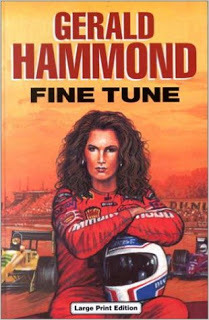 In the twenty-three Keith Calder novels and the eleven Three Oaks novels, Hammond created enduring characters with strong family ties. Often, Hammond let one of the series’ secondary characters take center stage if the plot revolved around something specific to their personality or situation. While I enjoyed Hammond’s series novels, some of my favorite Hammond tales were the standalones he wrote late in his career. These featured excitements or passions that caught his fancy, including Formula One racing—Fine Tune—and gliding—Into the Blue... For more on Gerald Hammond CLICK HERE Writing can be a lonely trade. This month make an effort to show appreciation for your favorite authors by leaving a review on Amazon or Goodreads. Let them know their efforts are reaching and entertaining readers...
In the twenty-three Keith Calder novels and the eleven Three Oaks novels, Hammond created enduring characters with strong family ties. Often, Hammond let one of the series’ secondary characters take center stage if the plot revolved around something specific to their personality or situation. While I enjoyed Hammond’s series novels, some of my favorite Hammond tales were the standalones he wrote late in his career. These featured excitements or passions that caught his fancy, including Formula One racing—Fine Tune—and gliding—Into the Blue... For more on Gerald Hammond CLICK HERE Writing can be a lonely trade. This month make an effort to show appreciation for your favorite authors by leaving a review on Amazon or Goodreads. Let them know their efforts are reaching and entertaining readers...
Published on May 18, 2016 16:38
April 11, 2016
FACING DOWN BEASTS, SAVAGES, SADISTIC NAZIS, AND WILD WOMEN
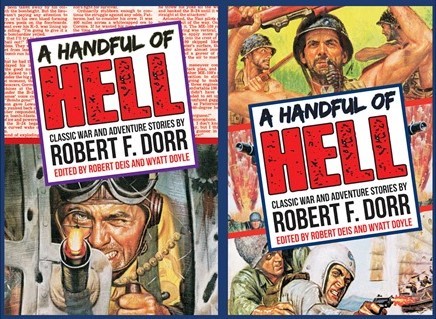 ROBERT F. DORR—FACING DOWN BEASTS, SAVAGES, SADISTIC NAZIS, AND WILD WOMEN...
ROBERT F. DORR—FACING DOWN BEASTS, SAVAGES, SADISTIC NAZIS, AND WILD WOMEN...
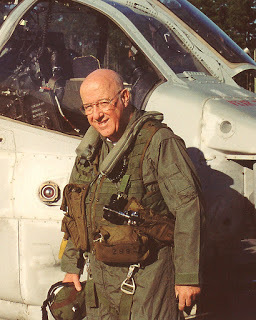 Robert F. Dorr is a writer’s writer—A man who has consistently put words on paper and been paid for them since he was sixteen years old. He has been a roving wordslinger for over six decades. His prodigious output includes 80 books, over 6,000 magazine articles/stories, and 2,000 columns. Almost all of his writing has been non-fiction featuring wartime aviation or military history. Last year, he completed and published two novels, Hitler’s Time Machine and Crime Scene: Fairfax County. These have been his first forays into the realm of fiction—if you don’t count the numerous "true stories" he wrote for the men’s adventure magazines.
Robert F. Dorr is a writer’s writer—A man who has consistently put words on paper and been paid for them since he was sixteen years old. He has been a roving wordslinger for over six decades. His prodigious output includes 80 books, over 6,000 magazine articles/stories, and 2,000 columns. Almost all of his writing has been non-fiction featuring wartime aviation or military history. Last year, he completed and published two novels, Hitler’s Time Machine and Crime Scene: Fairfax County. These have been his first forays into the realm of fiction—if you don’t count the numerous "true stories" he wrote for the men’s adventure magazines.
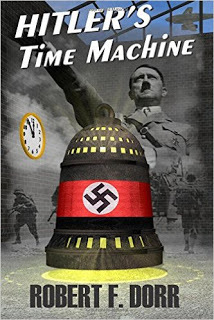
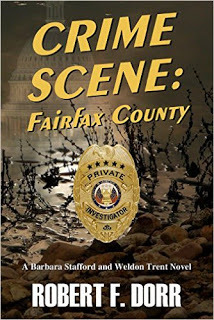 Now 76 years old, Bob was diagnosed in the latter part of 2015 with Glioblastoma Multiforme—a fatal form of brain cancer. Successful surgery removed the tumor, but the procedure only gave him a little more time before the inevitable. Bob, however, distains self-pity. He is upbeat, positive, and determined, continuing to promote his latest novels, reaching out to support other writers, while fearlessly interacting with the social communities made possible by new technologies. He regularly talks on the phone with well-wishers and fans, but knowing his time in mortality is short, he spares his deteriorating typing skills for writing notes of gratitude and love to friends and family. I first became aware of Bob though my interest in the
Men’s Adventure Magazine Blog
website and the associate
Men’s Adventure Magazine Facebook Group
. With his history of writing for the men’s adventure magazines, Bob was an active presence and knowledgeable contributor to both the website and the Facebook group.
Now 76 years old, Bob was diagnosed in the latter part of 2015 with Glioblastoma Multiforme—a fatal form of brain cancer. Successful surgery removed the tumor, but the procedure only gave him a little more time before the inevitable. Bob, however, distains self-pity. He is upbeat, positive, and determined, continuing to promote his latest novels, reaching out to support other writers, while fearlessly interacting with the social communities made possible by new technologies. He regularly talks on the phone with well-wishers and fans, but knowing his time in mortality is short, he spares his deteriorating typing skills for writing notes of gratitude and love to friends and family. I first became aware of Bob though my interest in the
Men’s Adventure Magazine Blog
website and the associate
Men’s Adventure Magazine Facebook Group
. With his history of writing for the men’s adventure magazines, Bob was an active presence and knowledgeable contributor to both the website and the Facebook group.
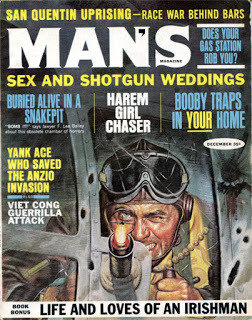 Moderated by Robert Deis, the
Men’s Adventure Magazine Blog
is the premier resource for collectors of the post-WWII men’s adventure magazines. The website presents an in-depth examination of the various aspects specific to the genre—the covers; the artists; the writers; the pulp-fiction style stories; the true (in the loosest sense) non-fiction articles; the vintage ads; and all other aspects of this style of magazine, which proliferated on America’s newsstands from the 1950s through the mid-1970s. On the allure of these publications, men’s adventure magazine guru Deis proclaims, “Grandpa didn't read Twilight…” With titles such as Men, All Man, Man’s Action, For Men Only, Male, Gusto, Untamed, an Man’s Life, the men’s adventure magazines left no male fantasy or interest unexplored. They are best remembered in pop culture for their vivid, lurid, and often titillating covers depicting bare-chested, all-American he-men, in close combat with sneering Nazis, savage island natives, wild beasts, and even wilder women.
Moderated by Robert Deis, the
Men’s Adventure Magazine Blog
is the premier resource for collectors of the post-WWII men’s adventure magazines. The website presents an in-depth examination of the various aspects specific to the genre—the covers; the artists; the writers; the pulp-fiction style stories; the true (in the loosest sense) non-fiction articles; the vintage ads; and all other aspects of this style of magazine, which proliferated on America’s newsstands from the 1950s through the mid-1970s. On the allure of these publications, men’s adventure magazine guru Deis proclaims, “Grandpa didn't read Twilight…” With titles such as Men, All Man, Man’s Action, For Men Only, Male, Gusto, Untamed, an Man’s Life, the men’s adventure magazines left no male fantasy or interest unexplored. They are best remembered in pop culture for their vivid, lurid, and often titillating covers depicting bare-chested, all-American he-men, in close combat with sneering Nazis, savage island natives, wild beasts, and even wilder women.
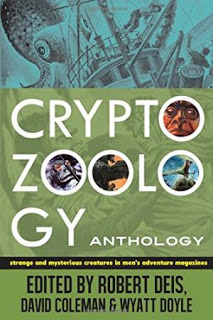 As an offshoot of the website, Deis—along with his partner in crime and publishing, Wyatt Doyle—created a series of beautifully crafted anthologies of stories torn from the pages of the men’s adventure magazines. Under the umbrella of The Men’s Adventure Library, Deis and Doyle have made some of the best of these great stories accessible again in three collections,
WeaselsRipped My Flesh
,
He-men Bag Men And Nymphos
, and
Cryptozoology
.
As an offshoot of the website, Deis—along with his partner in crime and publishing, Wyatt Doyle—created a series of beautifully crafted anthologies of stories torn from the pages of the men’s adventure magazines. Under the umbrella of The Men’s Adventure Library, Deis and Doyle have made some of the best of these great stories accessible again in three collections,
WeaselsRipped My Flesh
,
He-men Bag Men And Nymphos
, and
Cryptozoology
.
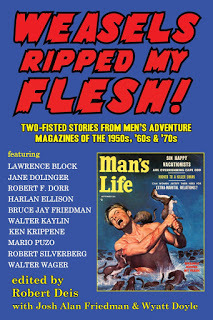 While two of Bob Dorr’s stories made it into Weasels Ripped My Flesh, Deis and Doyle decided a standalone collection of Dorr stories was a must. The resulting anthology, A Handful of Hell, was published in January. The stunning cover and beautifully reproduced illustrations from the original magazines make an inspiring canvas for the dynamite explosion of war action, valor, heroism, and down and dirty combat Dorr’s stories deliver.
While two of Bob Dorr’s stories made it into Weasels Ripped My Flesh, Deis and Doyle decided a standalone collection of Dorr stories was a must. The resulting anthology, A Handful of Hell, was published in January. The stunning cover and beautifully reproduced illustrations from the original magazines make an inspiring canvas for the dynamite explosion of war action, valor, heroism, and down and dirty combat Dorr’s stories deliver. 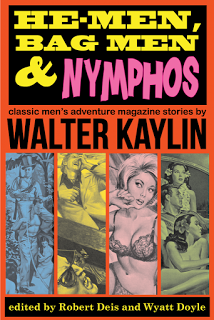 I recently had the pleasure of interviewing Bob about A Handful of Hell. Due to the cruel machinations of the brain cancer, he spoke slowly, but clearly on the phone from his home in Oakton, Virginia, where he lives with his wife, Young Soon, and keeps track of his two sons and their families. He can be blunt and irascible, not suffering fools gladly, but if he considers you a friend his generosity abounds. Since five years old, Bob was fascinated by the Air Force and military airplanes. When he was twelve, he bought a battered typewriter with money from his paper route, and began writing his first stories about planes. In 1962, after a four year tour with the Air Force where he became a Korean language expert, Bob began to pursue writing professionally.
I recently had the pleasure of interviewing Bob about A Handful of Hell. Due to the cruel machinations of the brain cancer, he spoke slowly, but clearly on the phone from his home in Oakton, Virginia, where he lives with his wife, Young Soon, and keeps track of his two sons and their families. He can be blunt and irascible, not suffering fools gladly, but if he considers you a friend his generosity abounds. Since five years old, Bob was fascinated by the Air Force and military airplanes. When he was twelve, he bought a battered typewriter with money from his paper route, and began writing his first stories about planes. In 1962, after a four year tour with the Air Force where he became a Korean language expert, Bob began to pursue writing professionally."The men’s adventure magazines were very visible on the drugstore racks, so I felt they must need somebody to write this stuff. I used Writer’s Digest to track down the editors and what the magazines were interested in. I then read the magazines to learn their style..."
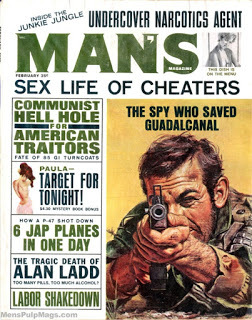 In 1965, he was attached to the Foreign Service arm of the U.S. State Department.
In 1965, he was attached to the Foreign Service arm of the U.S. State Department."When I started with the State Department in my frivolous youth, I wasn’t thinking about retirement. But I fortunately picked one of the two careers in the State Department where you could retire at age fifty." His duties with the State Department included becoming President Carter’s top expert on North Korea. However, none of his real world responsibilities stopped the pages flowing from his typewriter.
"When there was nothing else demanding my time for either job or family, I was at my desk with cigarettes and booze writing stories."
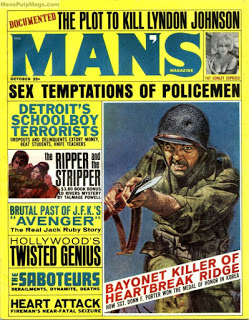 Wherever his State Department duties took him, Bob’s typewriter and writing records went along.
Wherever his State Department duties took him, Bob’s typewriter and writing records went along."I had a file folder for every story I sold. That folder contained all the correspondence related to that particular article or story. I kept a file drawer filled with these folders. When I moved on, so did my files..." Bob also wrote for the confession and love magazines, cranking out true exposés of the intimate secrets of airline stewardesses and other salacious sounding subjects, their content tame by today’s standards. However, it was Bob’s action-based "true" war stories for the men’s adventure magazines that kept him in cigarettes and booze until the mid-seventies.
"I often made up characters and events, but always tried to be true to what the men who read these magazines (mostly combat veterans) experienced."
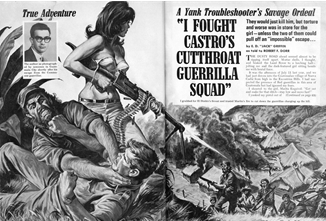 When the men’s adventure magazines disappeared from the newsstands, their hyper-action stories of combat, wild beasts, replaced by the "girly mags," which were more interested in nudes than words, Bob turned his skills to writing books about aviation.
When the men’s adventure magazines disappeared from the newsstands, their hyper-action stories of combat, wild beasts, replaced by the "girly mags," which were more interested in nudes than words, Bob turned his skills to writing books about aviation."I would like to feel, if I was called upon, I could write about anything...But the Air force and military aviation became my specialization..." His first book was a history of the Swedish Vinneg fighter plane, a standard fighter of the era built by SAAB. He received an advance of three hundred British pounds (approx. $750).
"I didn’t realize there was a new book about the F-16 being published every two weeks. I thought I had to write about something original…" More aviation related books and articles followed until leaving the Foreign Service in 1989.
"The same day I retired from the State Department, I started writing full time. For a while, I had the idea I was going to achieve the goal of a million words a year. I never quite made that level, but I tried. I wanted to be the next Norman Mailer...the next Hemingway, or James Jones, but It was not to be. I still have pieces of the Great American Novel all over my house, but I could never pull them all together..."
 In 2000, Bob found himself writing editorials for the Air Force Times. Known to be outspoken, he was a staunch defender of the military everyman. His op-ed pieces were never afraid to expose harsh truths senior military and Defense Department leadership might not want to hear.
In 2000, Bob found himself writing editorials for the Air Force Times. Known to be outspoken, he was a staunch defender of the military everyman. His op-ed pieces were never afraid to expose harsh truths senior military and Defense Department leadership might not want to hear."I interviewed the big guys to convey to them what the little guys wanted. Base visits were orchestrated and rarely told the brass what real airmen wanted and needed. My columns were for the ones doing the work. They have always given us better than we deserve…we owe everything to them."
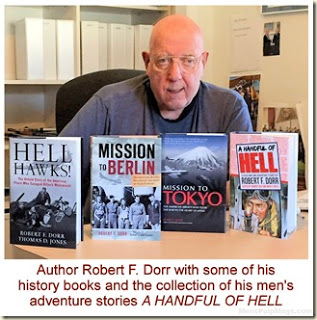 Bob is delighted and proud of A Handful of Hell making the best of his stories from the men’s adventure magazines available again.
Bob is delighted and proud of A Handful of Hell making the best of his stories from the men’s adventure magazines available again."My favorite is Night Intruders, which appeared in Real Magazine. It was real wartime fiction. It wasn’t a blown-up exaggerated topic, or overly hokey like other men’s adventure magazine stories." In typically generous fashion, he has recently donated his archives—140,000 8x10 photos, 100,000 color slides, 6,000 books—to the Glenn L. Martin Maryland Aviation Museum (along with several other charities) in Maryland, making them accessible to researchers. Bob says the secret to his writing success is easy.
"You have to put your bottom in the chair. It didn’t matter whether the sun was shining, whether I had the flu, or any other type of distraction, I sat at my desk and put words on paper. I tell young writers the same thing I tell my dog...Sit...Stay..." During the thirty-five years I spent as officer, detective, and detective supervisor in the trenches of the Los Angeles Police Department, there was a question we asked each other whenever a new lieutenant, captain, or deputy chief imposed themselves into our orbit—would you follow him or her up the hill? The question has its origins in military combat, but for all its simplicity, the answer is complex...Is this an individual who will lead from the front or sit behind the lines letting others face the bullets? Is this an individual whose actions will bring out the best in those for whom he or she is responsible? Is this an individual who will stand-up, or will they throw you under a tank at the first sign of trouble? Under pressure, when it all hits the fan, is this an individual you can trust to make hard decisions with lives on the line? Very few individuals met this criteria—the men and women you would follow up the hill into hell and beyond are diamonds amongst pyrite. I would follow Bob Dorr up the hill... FOR MORE ON A HANDFUL OF HELL CLICK HERE TO GET A SIGNED COPY FROM BOB CLICK HERE
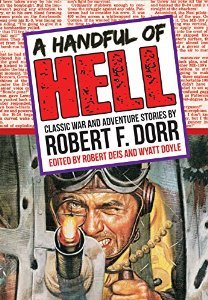


Published on April 11, 2016 20:52
RUNNING A FREE BOOK PROMOTION ON AMAZON ~ PART 2
 RUNNING A FREE BOOK PROMOTION ON AMAZON ~ PART 2 When Andrew Salmon told me he was preparing a three day free giveaway promotion for his book Sherlock Holmes: Work Capitol, I asked if he would document the process for an article and then later report on the results in a second article. He has graciously complied…While this process has been in place for quite a while, and has been written about and explored by experts for whom book promotion comes naturally, there are always writers new to the field who look to kindred spirits who are bravely going where they themselves wish to tread and who are willint to act as a guide or mentor... A THOUSAND FOLD ANDREW SALMON Well, the 3-day promotion is over, the dust has settled and it's time to tally up the results and recap the adventure. Here's how it all played out: DAY ONE As mentioned in Part One (Casting My Book Upon the Waters), I had put the time in to set up my promotion of Sherlock Holmes: Work Capitol. Free sites and pay sites had been contacted, book info sent and dates reserved. I was ready. So just after midnight, I began spreading the word via the first of the ads I'd created to promote the promotion. What was encouraging was seeing 80 downloads of the book before I'd pounded a key. So, yes, the reservations I had made at various sites were being honored. I decided to hit the ground running right at midnight because the promotion ran on all amazon sites in North America and overseas. Midnight on this continent is daytime elsewhere, right? And Facebook provides the incredible opportunity to promote all over the world. I didn't release the hounds at this point. Rather, it was a matter of getting the ball rolling, getting the word out as the sites I'd booked earlier were doing. Then hit the hay as a busy few days lay ahead.
RUNNING A FREE BOOK PROMOTION ON AMAZON ~ PART 2 When Andrew Salmon told me he was preparing a three day free giveaway promotion for his book Sherlock Holmes: Work Capitol, I asked if he would document the process for an article and then later report on the results in a second article. He has graciously complied…While this process has been in place for quite a while, and has been written about and explored by experts for whom book promotion comes naturally, there are always writers new to the field who look to kindred spirits who are bravely going where they themselves wish to tread and who are willint to act as a guide or mentor... A THOUSAND FOLD ANDREW SALMON Well, the 3-day promotion is over, the dust has settled and it's time to tally up the results and recap the adventure. Here's how it all played out: DAY ONE As mentioned in Part One (Casting My Book Upon the Waters), I had put the time in to set up my promotion of Sherlock Holmes: Work Capitol. Free sites and pay sites had been contacted, book info sent and dates reserved. I was ready. So just after midnight, I began spreading the word via the first of the ads I'd created to promote the promotion. What was encouraging was seeing 80 downloads of the book before I'd pounded a key. So, yes, the reservations I had made at various sites were being honored. I decided to hit the ground running right at midnight because the promotion ran on all amazon sites in North America and overseas. Midnight on this continent is daytime elsewhere, right? And Facebook provides the incredible opportunity to promote all over the world. I didn't release the hounds at this point. Rather, it was a matter of getting the ball rolling, getting the word out as the sites I'd booked earlier were doing. Then hit the hay as a busy few days lay ahead.
 When I stumbled out of bed hours later, I discovered 100s of readers had downloaded the book. Great! And I hadn't even started the full-on promotional juggernaut yet! I got to it. As I was offering a Sherlock Holmes book for free, my first contacts were the plethora of Holmes Facebook pages. I posted the first ad I'd created, with a direct link to the amazon page (always include a link) and announced a FREE Holmes book for their reading pleasure. Then I tweeted the news (with link) and as many hashtags for free e-book sites as I could squeeze into the tweet. Then it was back to Facebook and contacts (through dozens of book promotion pages) to 100,000s of readers. I posted on my wall of course. And I hit my friends and relatives up to not only encourage them to download the book, but also to help spread the word to anyone they might know who would be interested. And the numbers jumped! 200! 300! 400! The word was definitely getting out. I spread out my contacts, posts and tweets over the course of the day. This is important to remember. If you want the promo to work, you've got to work it. Sure, you can set it up, book the sites, send a tweet, post something on your wall, and just hope for the best. But if you want to be pro-active and increase your results, you've got to put the time in to utilize every avenue you can use to spread the word. There are 1000s of free e-books offered every day, everywhere! To get noticed, you can't just cross your fingers and wish. You've got to work. And the contacts have to be spread out: morning, noon, night. Yeah, it's an all day job. NUMBER OF FREE DOWNLOADS: 483 NUMBER OF OTHER E-BOOK SALES: 2 (One each of books #2 and #3 in the trilogy)
When I stumbled out of bed hours later, I discovered 100s of readers had downloaded the book. Great! And I hadn't even started the full-on promotional juggernaut yet! I got to it. As I was offering a Sherlock Holmes book for free, my first contacts were the plethora of Holmes Facebook pages. I posted the first ad I'd created, with a direct link to the amazon page (always include a link) and announced a FREE Holmes book for their reading pleasure. Then I tweeted the news (with link) and as many hashtags for free e-book sites as I could squeeze into the tweet. Then it was back to Facebook and contacts (through dozens of book promotion pages) to 100,000s of readers. I posted on my wall of course. And I hit my friends and relatives up to not only encourage them to download the book, but also to help spread the word to anyone they might know who would be interested. And the numbers jumped! 200! 300! 400! The word was definitely getting out. I spread out my contacts, posts and tweets over the course of the day. This is important to remember. If you want the promo to work, you've got to work it. Sure, you can set it up, book the sites, send a tweet, post something on your wall, and just hope for the best. But if you want to be pro-active and increase your results, you've got to put the time in to utilize every avenue you can use to spread the word. There are 1000s of free e-books offered every day, everywhere! To get noticed, you can't just cross your fingers and wish. You've got to work. And the contacts have to be spread out: morning, noon, night. Yeah, it's an all day job. NUMBER OF FREE DOWNLOADS: 483 NUMBER OF OTHER E-BOOK SALES: 2 (One each of books #2 and #3 in the trilogy)
 DAY TWO Back at it right out of the gate. A good 60 downloads while I was in the land of nod was an encouraging sign. I was more prudent this time out as I knew I'd be hitting contacts I'd already swamped on Day One. Finding the fine line between keeping things interesting and annoying your contacts, is the key to these things. I had a second ad prepared, a second pitch so as not to repeat myself. I hit different pages in the morning for a different international audience. A strategy of flipping the contacts (Day One morning folks get contacted again in the afternoon or evening of Day Two, Day One night folks get the word in the morning or afternoon on Day Two—you get the picture). And so it ran. Received some contact from downloaders, a thanks here, a looking forward to reading it there, the promise of a review every now and then. Great stuff! To keep things short and sweet here, it was more of the above. Tweeting with hashtags, posting on Facebook, letting the booked sites do their thing. As I had exhausted my contacts by this point, the results dropped off as folks had either downloaded the free e-book, were going to download it later, or weren't planning on doing so. NUMBER OF FREE DOWNLOADS: 267 NUMBER OF OTHER E-BOOK SALES: 1(My Black Bat adventure, DEATH RIDES THE VALKYRIE) DAY THREE This was a Saturday and I had high hopes for the results. Everyone's home, everyone's surfing, everyone's got free time to think about reading a free e-book.
DAY TWO Back at it right out of the gate. A good 60 downloads while I was in the land of nod was an encouraging sign. I was more prudent this time out as I knew I'd be hitting contacts I'd already swamped on Day One. Finding the fine line between keeping things interesting and annoying your contacts, is the key to these things. I had a second ad prepared, a second pitch so as not to repeat myself. I hit different pages in the morning for a different international audience. A strategy of flipping the contacts (Day One morning folks get contacted again in the afternoon or evening of Day Two, Day One night folks get the word in the morning or afternoon on Day Two—you get the picture). And so it ran. Received some contact from downloaders, a thanks here, a looking forward to reading it there, the promise of a review every now and then. Great stuff! To keep things short and sweet here, it was more of the above. Tweeting with hashtags, posting on Facebook, letting the booked sites do their thing. As I had exhausted my contacts by this point, the results dropped off as folks had either downloaded the free e-book, were going to download it later, or weren't planning on doing so. NUMBER OF FREE DOWNLOADS: 267 NUMBER OF OTHER E-BOOK SALES: 1(My Black Bat adventure, DEATH RIDES THE VALKYRIE) DAY THREE This was a Saturday and I had high hopes for the results. Everyone's home, everyone's surfing, everyone's got free time to think about reading a free e-book.
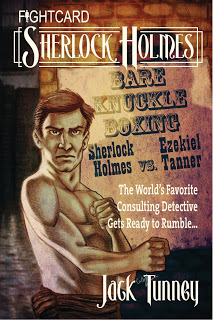 For me, I was making myself sick with all the promotion I'd been doing and couldn't help but fear I was making my contacts sick as well. Still, you've got to press on, keep things interesting (change the pitch, change the pictures you include with each post, change the hashtags on the tweets, etc.) and hope you don't turn too many people off your promotion. It has to be a blitzkrieg, but a considerate and considered one. Again, I flipped the Facebook posts, mixed things up, but hit each of my contacts again while letting the free e-book sites do their work. I also stayed in touch with anyone who contacted me concerning the promotion. A quick side note: I wasn't glued to my computer throughout the promotion. You don't have to be a hermit during the free days. But you do have to spend more time than you would normally working the phones so to speak. The results demonstrated what I had learned during my research into these promotions. Always have at least a Saturday as part of your free days. Mine ran from Thursday—Saturday. NUMBER OF FREE DOWNLOADS: 363 NUMBER OF OTHER E-BOOK SALES: 1 (One copy of the last book of the trilogy, A Congression Of Pallbearers) And that was it. I stepped back, took a deep breath and got to figuring. Here are the results: PROMOTION TOTALS: TOTAL NUMBER OF FREE DOWNLOADS: 1,113 TOTAL NUMBER OF OTHER E-BOOK SALES: 4 Safe to say folks prefer things for free. DAY FOUR Day 4 of a 3-day promotion? Yes, because things got interesting on Sunday. The promotion was over. And yet, Amazon showed 10 more downloads early Sunday. I'm guessing these happened right under the wire and carried over into the next day. But it upped the total number of free downloads to 1,123. But Sherlock Holmes Work Capitol also
sold
11 copies on Sunday!
For me, I was making myself sick with all the promotion I'd been doing and couldn't help but fear I was making my contacts sick as well. Still, you've got to press on, keep things interesting (change the pitch, change the pictures you include with each post, change the hashtags on the tweets, etc.) and hope you don't turn too many people off your promotion. It has to be a blitzkrieg, but a considerate and considered one. Again, I flipped the Facebook posts, mixed things up, but hit each of my contacts again while letting the free e-book sites do their work. I also stayed in touch with anyone who contacted me concerning the promotion. A quick side note: I wasn't glued to my computer throughout the promotion. You don't have to be a hermit during the free days. But you do have to spend more time than you would normally working the phones so to speak. The results demonstrated what I had learned during my research into these promotions. Always have at least a Saturday as part of your free days. Mine ran from Thursday—Saturday. NUMBER OF FREE DOWNLOADS: 363 NUMBER OF OTHER E-BOOK SALES: 1 (One copy of the last book of the trilogy, A Congression Of Pallbearers) And that was it. I stepped back, took a deep breath and got to figuring. Here are the results: PROMOTION TOTALS: TOTAL NUMBER OF FREE DOWNLOADS: 1,113 TOTAL NUMBER OF OTHER E-BOOK SALES: 4 Safe to say folks prefer things for free. DAY FOUR Day 4 of a 3-day promotion? Yes, because things got interesting on Sunday. The promotion was over. And yet, Amazon showed 10 more downloads early Sunday. I'm guessing these happened right under the wire and carried over into the next day. But it upped the total number of free downloads to 1,123. But Sherlock Holmes Work Capitol also
sold
11 copies on Sunday!
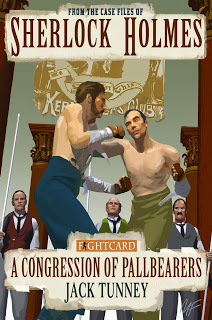 Folks who came late to the show, hopefully eager to see what all the fuss was about—remember me making myself and everyone on Facebook sick—found the book, realized they'd missed the promotion and shelled out the $2.99 to get in on the action. Or maybe, they just decided they wanted to help me out and buy the book instead of downloading it gratis. I'd heard of this happening and was gratified to be the lucky recipient of readers willing to buy the book after losing the chance to get it for free. A hearty thank you goes out to each and every one. FINAL NUMBERS TOTAL NUMBER OF FREE DOWNLOADS: 1,123 TOTAL NUMBER OF OTHER E-BOOK SALES: 15 A FINAL WORD It's important to remember you're playing the long game here. Looking at the above numbers, one can't help but do a little math and see what the royalties would have been if readers had bought the book rather than downloading it for free. Sure, those sales would have been nice—all right, I'll admit it, very nice—but immediate results are not what these free promotions are about. The key here is that 1,123 readers have my book who didn't have it before. Hopefully they will read it, like it, and want to read the next two for under $6 total. Maybe they buy a copy for a friend, want a print copy for themselves or to give as a gift, leave a review, tell their friends about it—these are the goals of free promotions. What I attained with the giveaway was 1,123 chances for the book to reach new readers, both Holmes fans and general readers alike, who may become fans of my work and willingly throw a few dollars my way for my other books. As this was the ultimate goal of the promotion, I can declare a big mission accomplished.
Folks who came late to the show, hopefully eager to see what all the fuss was about—remember me making myself and everyone on Facebook sick—found the book, realized they'd missed the promotion and shelled out the $2.99 to get in on the action. Or maybe, they just decided they wanted to help me out and buy the book instead of downloading it gratis. I'd heard of this happening and was gratified to be the lucky recipient of readers willing to buy the book after losing the chance to get it for free. A hearty thank you goes out to each and every one. FINAL NUMBERS TOTAL NUMBER OF FREE DOWNLOADS: 1,123 TOTAL NUMBER OF OTHER E-BOOK SALES: 15 A FINAL WORD It's important to remember you're playing the long game here. Looking at the above numbers, one can't help but do a little math and see what the royalties would have been if readers had bought the book rather than downloading it for free. Sure, those sales would have been nice—all right, I'll admit it, very nice—but immediate results are not what these free promotions are about. The key here is that 1,123 readers have my book who didn't have it before. Hopefully they will read it, like it, and want to read the next two for under $6 total. Maybe they buy a copy for a friend, want a print copy for themselves or to give as a gift, leave a review, tell their friends about it—these are the goals of free promotions. What I attained with the giveaway was 1,123 chances for the book to reach new readers, both Holmes fans and general readers alike, who may become fans of my work and willingly throw a few dollars my way for my other books. As this was the ultimate goal of the promotion, I can declare a big mission accomplished.
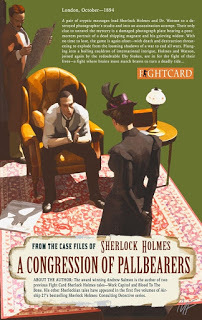 Also, the 15 sales I picked up are not going to give James Patterson anything to worry about, but every sale is important. Free downloads aside, Sherlock Holmes Work Capitol came out a few years ago and had its moment in the sun with a couple of award nominations and positive reviews from readers and critics alike, so any bump in sales is welcome. At the very least, the sales allowed me to recoup the $20 I paid to set-up the promotion. In fact, I came out a few dollars ahead. I'm happy with that result, because who knows what future sales the promotion will create. With over 1,100 new readers, I'm bound to hook some of them with my ability to bump one word up against another. I'm already ahead of the game, if only slightly. I cast my book upon the waters and time will tell if it comes back to me a thousand fold—so far, so good.
Also, the 15 sales I picked up are not going to give James Patterson anything to worry about, but every sale is important. Free downloads aside, Sherlock Holmes Work Capitol came out a few years ago and had its moment in the sun with a couple of award nominations and positive reviews from readers and critics alike, so any bump in sales is welcome. At the very least, the sales allowed me to recoup the $20 I paid to set-up the promotion. In fact, I came out a few dollars ahead. I'm happy with that result, because who knows what future sales the promotion will create. With over 1,100 new readers, I'm bound to hook some of them with my ability to bump one word up against another. I'm already ahead of the game, if only slightly. I cast my book upon the waters and time will tell if it comes back to me a thousand fold—so far, so good. The next article was written after the results of the giveaway promotion of Sherlock Holmes Work Capitol were in... FOR MORE ON SHERLOCK HOLMES: WORK CAPITOL CLICK HERE <iframe style="width:120px;height:240px;" marginwidth="0" marginheight="0" scrolling="no" frameborder="0" src="http://www.paulbishopbooks.com//ws-na... style="width:120px;height:240px;" marginwidth="0" marginheight="0" scrolling="no" frameborder="0" src="http://www.paulbishopbooks.com//ws-na...
Published on April 11, 2016 20:50



